The Project Gutenberg eBook of Antarctic Penguins: A Study of Their Social Habits
most other parts of the world at no cost and with almost no restrictions
whatsoever. You may copy it, give it away or re-use it under the terms
of the Project Gutenberg License included with this ebook or online
at www.gutenberg.org. If you are not located in the United States,
you will have to check the laws of the country where you are located
before using this eBook.
Title: Antarctic Penguins: A Study of Their Social Habits
Author: G. Murray Levick
Release date: August 1, 2011 [eBook #36922]
Language: English
Credits: Produced by Jana Srna and the Online Distributed
Proofreading Team at https://www.pgdp.net (This file was
produced from images generously made available by
Biodiversity Heritage Library.)
*** START OF THE PROJECT GUTENBERG EBOOK ANTARCTIC PENGUINS: A STUDY OF THEIR SOCIAL HABITS ***
Transcriber's Notes:
Every effort has been made to replicate
this text as faithfully as possible, including inconsistencies
in spelling and hyphenation.
Some corrections of spelling and punctuation have been made.
They are marked like
this in the text. The original text appears when hovering the cursor
over the marked text. A list of amendments is
at the end of the text.

ANTARCTIC PENGUINS
THE HEART OF THE
ANTARCTIC. Being a Story of the British
Antarctic Expedition, 1907–1909. By Sir
E. H. Shackleton, C.V.O. With Introduction by
Hugh Robert Mill, D.S.O. An Account of
the First Journey to the South Magnetic
Pole by Professor T. W. Edgworth David,
F.R.S. 2 vols., crown 4to. Illustrated with
Maps and Portraits. 36s net. Edition de
Luxe, with Autographs, Special Contributions,
Etched Plates, and Pastel Portraits. £10 10s
net. New and Revised Edition. With Coloured
Illustrations and Black and White. Crown 8vo,
6s net.
SHACKLETON IN THE
ANTARCTIC. (Hero Readers.) Crown
8vo, 1s 6d.
LOST IN THE ARCTIC. Being
the Story of the “Alabama” Expedition. By
Captain Ejnar Mickelson. Crown 4to. Illustrations
and Maps. 18s net.
IN NORTHERN MISTS. Arctic
Exploration in Early Times. By
Fridtjof Nansen. With numerous Illustrations and
Coloured Frontispieces. 2 vols., cr. 4to, 30s net.
LONDON: WILLIAM HEINEMANN
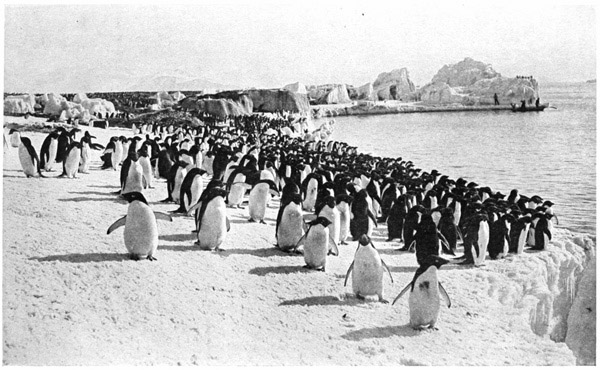
“OCCASIONALLY AN UNACCOUNTABLE ‘BROODINESS’ SEEMED TO TAKE POSSESSION OF THE PENGUINS” (Page 108)
Frontispiece
ANTARCTIC
PENGUINS
A STUDY OF THEIR SOCIAL HABITS
BY
DR. G. MURRAY LEVICK, R.N.
ZOOLOGIST TO THE BRITISH ANTARCTIC EXPEDITION
[1910–1913]

LONDON
WILLIAM HEINEMANN
First Published March 1914
Second Impression May 1914
LONDON: WILLIAM HEINEMANN 1914
CONTENTS
| PAGE | |
|---|---|
| INTRODUCTION | 1 |
| PART I | |
| THE FASTING PERIOD | 17 |
| PART II | |
| DOMESTIC LIFE OF THE ADÉLIE PENGUIN | 51 |
| APPENDIX | 119 |
| PART III | |
| McCORMICK'S SKUA GULL | 125 |
| A SHORT NOTE ON EMPEROR PENGUINS | 134 |
LIST OF ILLUSTRATIONS
| “Occasionally an unaccountable ‘broodiness’ seemed to take possession of the penguins” | Frontispiece |
| To face p. | |
| An angry Adélie | 2 |
| Dozing | 4 |
| Waking up, stretching, and yawning | 4 |
| Pack-ice | 8 |
| Heavy seas in the autumn | 8 |
| “throw up masses of ice” | 10 |
| “which are frozen into a compact mass” | 10 |
| “and later, form the beautiful terraces of the ice-foot” | 14 |
| Penguins at the rookery | 14 |
| In the foreground a mated pair have begun to build | 20 |
| The rookery beginning to fill up | 22 |
| “The hens would keep up this peck-pecking hour after hour” | 24 |
| An affectionate couple | 24 |
| “Side by side … nests of very big stones and nests of very small stones” | 26 |
| On the march to the rookery | 28 |
| Part of the line of approaching birds, several miles in length | 30 |
| Arriving at the rookery | 32, 34 |
| Adélies arriving | 36 |
| A cock carrying a stone to his nest | 36 |
| Several interesting things are taking place here | 38 |
| Three cocks in rivalry | 40 |
| Two of the cocks squaring up for battle | 40 |
| Hard at it | 42 |
| The end of the battle | 42 |
| The proposal | 44 |
| Cocks fighting for hens | 46, 48 |
| Penguin on nest | 48 |
| Showing the position of the two eggs | 50 |
| An Adélie in “ecstatic” attitude | 50 |
| Floods | 52 |
| Flooded | 54 |
| A nest with stones of mixed sizes | 54 |
| “Hour after hour … they fought again and again” | 56 |
| A nest on a rock | 58 |
| “One after another, the rest of the party followed him” | 58 |
| A joy ride | 60 |
| A knot of penguins on the ice-foot | 62 |
| An Adélie leaping from the water | 64 |
| An Adélie leaping four feet high and ten feet long | 66 |
| Jumping on to slippery ice | 68 |
| “When they succeeded in pushing one of their number over, all would crane their necks over the edge” | 70 |
| Diving flat into shallow water | 72, 74, 76, 78 |
| Adélies “porpoising” | 78 |
| A perfect dive into deep water | 80 |
| Sea-leopards “lurk beneath the overhanging ledges” | 82 |
| A sea-leopard's head | 84 |
| A sea-leopard 10 ft. 6½ in. long | 86 |
| A young sea-leopard on sea-ice | 86 |
| “With graceful arching of his neck, appeared to assure her of his readiness to take charge” | 88 |
| “The chicks began to appear” | 90 |
| An Adélie being sick | 90 |
| Method of feeding the young | 92 |
| Profile of an Adélie chick | 94 |
| A task becoming impossible | 96 |
| Adélie with chick twelve days old | 98 |
| A couple with their chicks | 100 |
| Adélie penguins have a strong love of climbing for its own sake | 102 |
| Adélies on the ice-foot | 104, 106, 108 |
| “An imprisoned hen was poking her head up” | 110 |
| “Her mate appeared to be very angry with her” | 110 |
| “When she broke out, they became reconciled” | 112 |
| Adélie nests on top of Cape Adare | 112 |
| “Leapt at one another into the air” | 130 |
| A Skua by its chick | 130 |
| An Emperor Penguin | 134 |
| Profile of an Emperor | 136 |
ADÉLIE PENGUINS(1)
INTRODUCTION
The penguins of the Antarctic regions very rightly
have been termed the true inhabitants of that
country. The species is of great antiquity, fossil
remains of their ancestors having been found,
which showed that they flourished as far back as the
eocene epoch. To a degree far in advance of any
other bird, the penguin has adapted itself to the sea
as a means of livelihood, so that it rivals the very
fishes. This proficiency in the water has been
gained at the expense of its power of flight, but
this is a matter of small moment, as it happens.
In few other regions could such an animal as
the penguin rear its young, for when on land
its short legs offer small advantage as a means
of getting about, and as it cannot fly, it would
become an easy prey to any of the carnivora which
abound in other parts of the globe. Here, however,
there are none of the bears and foxes which inhabit
the North Polar regions, and once ashore the penguin
is safe.
The reason for this state of things is that there is
no food of any description to be had inland. Ages
back, a different state of things existed: tropical
forests abounded, and at one time, the seals ran
about on shore like dogs. As conditions changed,
these latter had to take to the sea for food, with the
result that their four legs, in course of time, gave
place to wide paddles or “flippers,” as the penguins'
wings have done, so that at length they became
true inhabitants of the sea.
Were the Sea-Leopards(2) (the Adélies' worst
enemy) to take to the land again, there would be a
speedy end to all the southern penguin rookeries.
As these, however, are inhabited only during four
and a half months of the year, the advantage to
the seals in growing legs again would not be great
enough to influence evolution in that direction. At
the same time, I wonder very much that the sea-leopards,
who can squirm along at a fair pace
on land, have not crawled up the few yards of ice-foot
intervening between the water and some of
the rookeries, as, even if they could not catch
the old birds, they would reap a rich harvest among
the chicks when these are hatched. Fortunately
however they never do this.
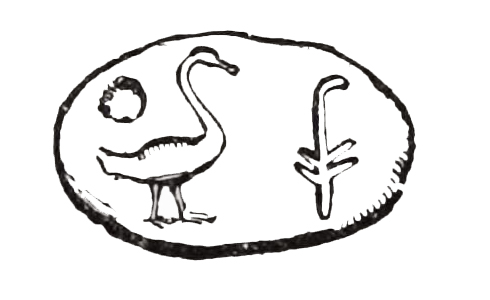
Fig. 1. AN ANGRY ADÉLIE
(Page 3)
When seen for the first time, the Adélie penguin
gives you the impression of a very smart little man
in an evening dress suit, so absolutely immaculate is
he, with his shimmering white front and black back
and shoulders. He stands about two feet five inches
in height, walking very upright on his little legs.
His carriage is confident as he approaches you over
the snow, curiosity in his every movement. When
within a yard or two of you, as you stand silently
watching him, he halts, poking his head forward
with little jerky movements, first to one side, then
to the other, using his right and left eye alternately
during his inspection. He seems to prefer using
one eye at a time when viewing any near object,
but when looking far ahead, or walking along,
he looks straight ahead of him, using both eyes.
He does this, too, when his anger is aroused,
holding his head very high, and appearing to squint
at you along his beak, as in Figure 1.
After a careful inspection, he may suddenly lose
all interest in you, and ruffling up his feathers sink
into a doze. Stand still for a minute till he has
settled himself to sleep, then make sound enough
to wake him without startling him, and he opens
his eyes, stretching himself, yawns, then finally walks
off, caring no more about you. (Figs. 2 and 3.)
The wings of Adélies, like those of the other
penguins, have taken the form of paddles, and are
covered with very fine scale-like feathers. Their
legs being very short, they walk slowly, with a
waddling gait, but can travel at a fair pace over
snow or ice by falling forward on to their breasts,
and propelling themselves with all four limbs.
To continue the sketch, I quote two other
writers:
M. Racovitza, of the “Belgica” expedition, well
describes them as follows:
“Imagine a little man, standing erect, provided
with two broad paddles instead of arms, with head
small in comparison with the plump stout body;
imagine this creature with his back covered with a
black coat … tapering behind to a pointed tail
that drags on the ground, and adorned in front
with a glossy white breast-plate. Have this creature
walk on his two feet, and give him at the same
time a droll little waddle, and a pert movement
of the head; you have before you something
irresistibly attractive and comical.”
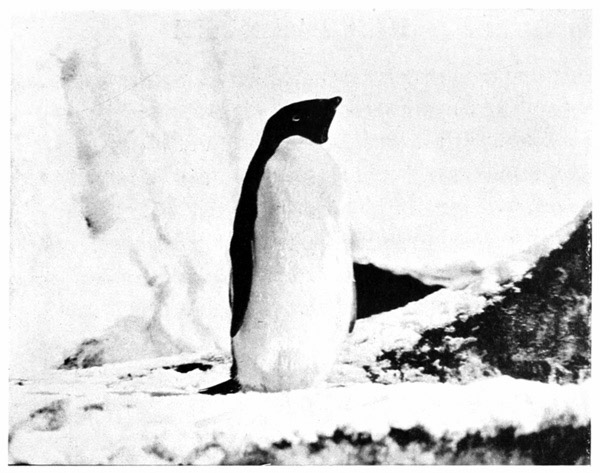
Fig. 2. Dozing
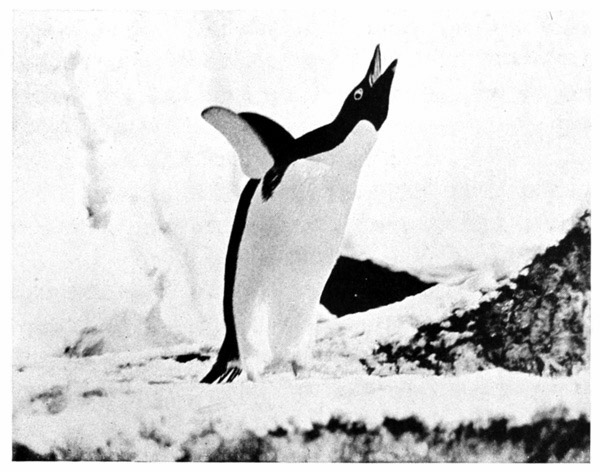
Fig. 3. Waking up, Stretching, and Yawning
(Page 3)
Dr. Louis Gain, of the French Antarctic expedition,
gives us the following description:
“The Adélie penguin is a brave animal, and
rarely flees from danger. If it happens to be
tormented, it faces its aggressor and ruffles the
black feathers which cover its back. Then it takes
a stand for combat, the body straight, the animal
erect, the beak in the air, the wings extended, not
losing sight of its enemy.
“It then makes a sort of purring, a muffled
grumbling, to show that it is not satisfied, and has
not lost a bit of its firm resolution to defend itself.
In this guarded position it stays on the spot; sometimes
it retreats, and lying flat on the ground,
pushes itself along with all the force of its claws and
wings. Should it be overtaken, instead of trying
to increase its speed, it stops, backs up again to
face anew the peril, and returns to its position
of combat. Sometimes it takes the offensive,
throws itself upon its aggressor, whom it punishes
with blows of its beak and wings.”
The Adélie penguin is excessively curious, taking
great pains to inspect any strange object he may
see. When we were waiting for the ship to fetch
us home, some of us lived in little tents which we
pitched on the snow about fifty yards from the edge
of the sea. Parties of penguins from Cape Royds
rookery frequently landed here, and almost invariably
the first thing they did on seeing our tents,
was at once to walk up the slope and inspect these,
walking all round them, and often staying to doze by
them for hours. Some of them, indeed, seemed to
enjoy our companionship. When you pass on the
sea-ice anywhere near a party of penguins, these
generally come up to look at you, and we had great
trouble to keep them away from the sledge dogs
when these were tethered in rows near the hut at
Cape Evans. The dogs killed large numbers of
them in consequence, in spite of all we could do to
prevent this.
The Adélies, as will be seen in these pages, are
extremely brave, and though panic occasionally
overtakes them, I have seen a bird return time after
time to attack a seaman who was brutally sending
it flying by kicks from his sea-boot, before I arrived
to interfere. An exact description of the plumage
of the Adélie penguins will be found in the Appendix,
as it is more especially of their habits that I intend
to treat in this work.
Before describing these, and with a view to making
them more intelligible to the general reader, I will
proceed to a short explanation.
The Adélie penguins spend their summer and
bring forth their young in the far South. Nesting
on the shores of the Antarctic continent, and on the
islands of the Antarctic seas, they are always close
to the water, being dependent on the sea for their
food, as are all Antarctic fauna; the frozen regions
inland, for all practical purposes, being barren of
both animal and vegetable life.
Their requirements are few: they seek no shelter
from the terrible Antarctic gales, their rookeries in
most cases being in open wind-swept spots. In fact,
three of the four rookeries I visited were possibly in
the three most windy regions of the Antarctic. The
reason for this is that only wind-swept places are so
kept bare of snow that solid ground and pebbles
for making nests are to be found.
When the chicks are hatched and fully fledged,
they are taught to swim, and when this is accomplished
and they can catch food for themselves, both
young and old leave the Southern limits of the sea,
and make their way to the pack-ice out to the
northward, thus escaping the rigors and darkness
of the Antarctic winter, and keeping where they
will find the open water which they need. For in
the winter the seas where they nest are completely
covered by a thick sheet of ice which does not
break out until early in the following summer.
Much of this ice is then borne northward by tide
and wind, and accumulates to form the vast rafts
of what is called “pack-ice,” many hundreds of
miles in extent, which lie upon the surface of the
Antarctic seas. (Fig. 4.)
It is to this mass of floating sea-ice that the
Adélie penguins make their way in the autumn,
but as their further movements here are at present
something of a mystery, the question will be
discussed at greater length presently.
When young and old leave the rookery at the
end of the breeding season, the new ice has not yet
been formed, and their long journey to the pack
has to be made by water, but they are wonderful
swimmers and seem to cover the hundreds of miles
quite easily.
Arrived on the pack, the first year's birds remain
there for two winters. It is not until after their
first moult, the autumn following their departure
from the rookery, that they grow the distinguishing
mark of the adult, black feathers replacing the
white plumage which has hitherto covered the
throat.
The spring following this, and probably every
spring for the rest of their lives, they return South
to breed, performing their journey, very often, not
only by water, but on foot across many miles
of frozen sea.
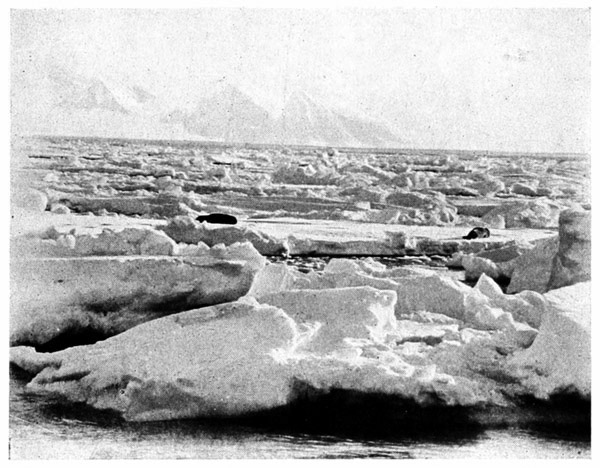
Fig. 4. Pack Ice (on which the Adélies winter)
Two Weddell Seals are seen on a Floe

Fig. 5. Heavy Seas in the Autumn
(Page 10)
For those birds who nest in the southernmost
rookeries, such as Cape Crozier, this journey must
mean for them a journey of at least four hundred
miles by water, and an unknown but considerable
distance on foot over ice.
As I am about to describe the manners and
customs of Adélie penguins at the Cape Adare
rookery, I will give a short description of that spot.
Cape Adare is situated in lat. 71° 14′ S. long.
170° 10′ E., and is a neck of land jutting out from
the sheer and ice-bound foot-hills of South Victoria
Land northwards for a distance of some twenty
miles.
For its whole length, the sides of this Cape
rise sheer out of the sea, affording no foothold
except at the extreme end, where a low beach
has been formed, nestling against the steep side of
the cliff which here rises almost perpendicularly to
a height of over 1000 feet.
Hurricanes frequently sweep this beach, so that
snow never settles there for long, and as it is composed
of basaltic material freely strewn with
rounded pebbles, it forms a convenient nesting site,
and it was on this spot that I made the observations
set forth in the following pages.
Viewed before the penguins' arrival in the spring,
and after recent winds had swept the last snowfalls
away, the rookery is seen to be composed of a
series of undulations and mounds, or “knolls,”
while several sheets of ice, varying in size up to some
hundreds of yards in length and one hundred yards
in width, cover lower lying ground where lakes
of thaw water form in the summer. Though
doubtless the ridges and knolls of the rookery
owe their origin mainly to geological phenomena,
their contour has been much added to as, year
by year, the penguins have chosen the higher
eminences for their nests; because their guano,
which thickly covers the higher ground, has
protected this from weathering and the denuding
effect of the hurricanes which pass over it at
certain seasons and tend to carry away the small
fragments of ground that have been split up by the
frost.
The shores of this beach are protected by a
barrier of ice-floes which are stranded there by the
sea in the autumn. These floes become welded
together and form the “ice-foot” frequently referred
to in these pages, and photographs showing
how this is done are seen on Figs. 5, 6, 7 and 8.
At the back of the rookery, nesting sites are
to be seen stretching up the steep cliff to a height
of over 1000 feet, some of them being almost
inaccessible, so difficult is the climb which the
penguins have made to reach them.

Fig. 6. “… Throw up Masses of Ice,
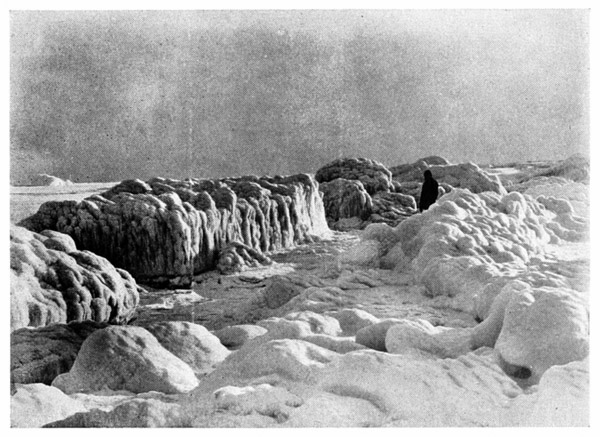
Fig. 7. “… Which are Frozen into a Compact Mass as
Winter approaches”
(Page 10)
On Duke of York Island, some twenty miles
south of the Cape Adare rookery, another breeding-place
has been made. This is a small colony only,
as might be expected. Indeed it is difficult to see
why the penguins chose this place at all whilst room
still exists at the bigger rookery, because Duke of
York Island, until late in the season, is cut off from
open water by many miles of sea-ice, so that with
the exception of an occasional tide crack, or seals'
blow holes, the birds of that rookery have no means
of getting food except by making a long journey on
foot. When the arrivals were streaming up to Cape
Adare many were seen to pass by, making in a
straight line for Duke of York Island, and so adding
another twenty miles on foot to the journey they
had already accomplished.
When the time arrived for the birds to feed, some
open leads had formed about half way across the
bay, and those of the Duke of York colony were to
be seen streaming over the ice for many miles on
their way between the water and their nests. They
seem to think nothing of long journeys, however,
as in the early season, when unbroken sea-ice intervened
between the two rookeries, parties of
penguins from Cape Adare actually used to march
out and meet their Duke of York friends half way
over, presumably for the pleasure of a chat.
To realize what this meant, we must remember that
an Adélie penguin's eyes being only about twelve
inches above the ground when on the march, his
horizon is only one mile distant. Thus from Cape
Adare he could just see the top of the mountain on
Duke of York Island peeping above the horizon on
the clearest day. In anything like thick weather he
could not see it at all, and probably he had never
been there. So in the first place, what was it that
impelled him to go on this long journey to meet his
friends, and when so impelled, what instinct pointed
out the way? This of course merely brings us to
the old question of migratory instinct, but in the
case of the penguin, its horizon is so very short that
it is quite evident he possesses a special sense of
direction, in addition to the special sense which
urged him to go and meet the Duke of York Island
contingent, and I may here remark that when we
were returning to New Zealand in the summer of
1913, we passed troops of penguins swimming in the
open sea far out of sight of land,—an unanswerable
reply to those naturalists who still maintain that
migrating birds must rely upon their eyes for
guidance, and this remark applies equally to the
penguins we found on the northern limits of the
pack-ice, some five hundred miles from the rookeries
to which they would repair the following year.
| Mean date | Northern limit of pack | Miles from C. Adare | Southern limit of pack | Miles of pack N. and S. | Remarks |
|---|---|---|---|---|---|
| Feb. 3, 1839 | 68° S. | 190 | ? | ? | Balleny |
| Jan. 1, 1841 | 66° 30′ | 280 | 69° | 150 | Ross |
| Feb. 1, 1895 | 66° 15′ | 300 | 69° 45′ | 210 | Kristensen |
| Feb. 8, 1899 | 66° 0′ | 315 | 69° 0′ | 180 | Borchgravink |
| Feb. 27, 1904 | ? | 70° 30′ | ? | Scott | |
| Feb. 15, 1910 | nil | nil | Terra Nova | ||
| Mar. 13, 1912 | nil | nil | Terra Nova | ||
| Jan. 30, 1913 | nil | nil | Terra Nova |
Note.—Ross, Kristensen, Scott, Shackleton and Pennell all, however, found pack late
in the season while trying to work west along the coast when only some forty-five to
seventy-five miles north of Cape Adare, and all were turned by this pack.
According to Pennell, it appears probable that there is a great hang of pack in the
sea west of Cape Adare and south of the Balleny Islands, and most likely it is here that
the Adélies repair when they leave Cape Adare rookery in the autumn. I think, however,
it is safe to assume that they seek the northernmost limits of the pack during the winter,
as these would offer the most favourable conditions.
| Date | Longitude | Northern limit | Extends N. and S. Miles | Minutes of latitude Northern limit is N. of Cape Adare |
|---|---|---|---|---|
| Jan. 12, 1840 | 166° E. | 64° 30′ | — | 400 (Wilkes) |
| Jan. 3, 1902 | 178° E. | 67° S. | 140 | 250 (Discovery) |
| Dec. 31, 1902 | 180° E. | 66° 30′ | 60 | 280 (Morning) |
| Second belt | 69° | 30 | 130 (Morning) | |
| Dec. 20, 1908 | 178° W. | 66° 30′ | 60 | 270 (Nimrod) |
| Dec. 9, 1910 | 178° W. | 64° 45′ | 300 | 390 (Terra Nova) |
| Dec. 27, 1911 | 177° W. | 65° 20′ | 160 | 360 (Terra Nova) |
| Mar. 8, 1911 | 162° E. | 64° 30′ | 270 | 400 (Terra Nova) |

Fig. 8. “… And later, form the Beautiful Terraces of
the Ice-foot”
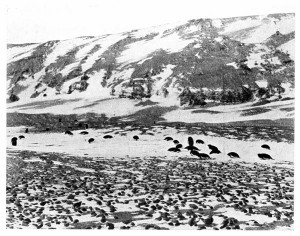
Fig. 9. Penguins at the Rookery
(Page 18)
The exact whereabouts of the Adélie penguins
during the winter months has been much discussed
by different writers. It is agreed that they repair
to the pack-ice, but our knowledge of the movements
of this pack is very vague at the present
time, and so unfortunately I can give but a rough
idea of the subject.
I have collected and noted down the latest
evidence for the benefit of the zoologists of future
expeditions who may wish to investigate the matter
further, and I am indebted for nearly the whole of
it to Commander Harry L. Pennell, R.N., commander
of the Terra Nova from 1910 to 1913,
who kindly drew up for me Tables A and B (see
pp. 13 and 14).
Probably the information which more nearly concerns
the penguins of Cape Adare rookery will be
found in Table A. The birds from Cape Crozier
and Cape Royds rookeries must have some four
hundred miles further to travel when they go North
in the autumn than those at Cape Adare.
PART I
THE FASTING PERIOD
Diary from October 13 to November 3, describing the
arrival of the Adélie penguins at the rookery, and
habits during the periods of mating and building.
The first Adélie penguins arrived at the Ridley
Beach rookery, Cape Adare, on October 13. A
blizzard came on then, with thick drift which
prevented any observations being made. The
next day, when this subsided, there were no penguins
to be seen.
On October 15 two of them were loitering about
the beach. During the forenoon they were separate,
but in the afternoon they kept company, and
walked over to the south-east corner of the rookery
under the cliff of Cape Adare, where they were
sheltered from the cold breeze.
On October 16 at 11 A.M. there were about
twenty penguins arrived. Several came singly,
and one little party of three came up together.
On arrival they wandered about by themselves,
and stood or walked about the beach, giving one
the impression of simply hanging about, waiting
for something to “turn up.”
By 4 P.M. there must have been close on a
hundred penguins at the rookery. It was a calm
day and misty, so that I could not see far out
across the sea-ice, but so far it was evident that
the birds were not arriving in batches, but just
dribbling in. They were then for the most part
squatting about the rookery, well scattered, some
solitary, others in groups, and facing in all directions.
(Fig. 9.) They were not on the prominences
where the nesting sites are, but in the
hollows and on the snow of the frozen lakes.
There was no sign of love-making or any activity
whatever. All were in fine plumage and condition.
During the night of October 16 the number of
penguins increased greatly, and on the morning of
the 17th there was a thin sprinkling scattered over
the rookery. (Fig. 11.) A few were in pairs or
threes, but more in groups of a dozen or more, and
all the birds were very phlegmatic, many of them
lying on their breasts, with beaks outstretched,
apparently asleep, and nearly all, as yesterday, in
the hollows, though there was no wind, and away
from the nesting sites. They were very quiet.
Probably they were fatigued after their journey;
perhaps also they were waiting the stimulation of a
greater crowd before starting their breeding operations.
As the guano-covered ridges, on which the
old nests are, were fairly soft and the pebbles
loose, they were not waiting for higher temperatures
in order to get to work.
During October 17 the arrivals became gradually
more frequent. They were dribbling up from the
sea-ice at the north-end of the beach, and soon
made a well-worn track up the ice-foot, whilst a
long line of birds approaching in single file, with
some gaps, extended to the horizon in a northerly
direction.
During the day I noticed some penguins taking
possession of old nests on the ridges. These mostly
squatted in the nests without any attempt at
repairing them or rearrangement of any sort.
Afterwards I found that they were unmated hens
waiting for mates to come to them, and that this
was a very common custom among them. (Fig. 10.)
If two occupied nests within reach of one another
they would stretch out their necks and peck at
each other. Their endeavour seemed to be to peck
each other's tongue, and this they frequently did,
but generally struck the soft parts round the margin
of the bills, which often became a good deal swollen
in consequence. Often also their beaks would
become interlocked. They would keep up this
peck-pecking hour after hour in a most relentless
fashion. (Fig. 12.) On one occasion I saw a hen
succeed in driving another off one of the old nests
which she occupied. The vanquished one squatted
on the ground a few yards away, with rumpled
feathers and “huffy” appearance, whilst the other
walked on to the nest and assumed the “ecstatic”
attitude (page 46). Nothing but animosity could
have induced this act, as thousands of old unoccupied
nests lay all around.
About 9 P.M. a light snowstorm came on,
and those few birds who had taken possession
of nests, left them, and all now lay in the hollows,
nestling into the fine drift which soon covered the
ground to the extent of a few inches. A group of
about a dozen penguins which arrived near the ice-foot
in the morning, halted on the sea-ice without
ascending the little slope leading to the rookery,
and stayed there all day.
With the few exceptions I have noted above, all
the birds that had arrived so far either were
much fatigued, or else they realized that they had
come a little too soon and were waiting for some
psychological moment to arrive, for they were all
strangely quiet and inactive.
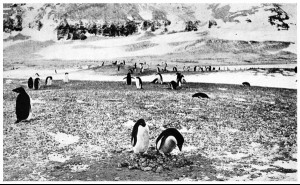
Fig. 10. IN THE FOREGROUND A MATED PAIR HAVE BEGUN TO BUILD. BEHIND AND TO THE RIGHT TWO UNMATED HENS LIE IN THEIR SCOOPS
(Page 19)
On October 18 the weather cleared and a
fair number of penguins started to build their
nests. The great majority however, apparently
resting, still sat about. Those that built took
their stones from old nests, as at present so many
of these lay unoccupied. They made quite large
nests, some inches high at the sides, with a comfortable
hollow in the middle to sit in. The stone
carrying (Fig. 20) was done by the male birds, the
hens keeping continual guard over the nest, as
otherwise the pair would have been robbed of the
fruits of their labours as fast as they were acquired.
As I strolled through the rookery, most of
the birds took little or no notice of me. Some,
however, swore at me very savagely, and one
infuriated penguin rushed at me from a distance of
some ten yards, seizing the leg of my wind-proof
trousers. In the morning quite a large number lay
down on the sea-ice, a few yards short of the
rookery, content apparently to have got so far.
They lay there all day, motionless on their breasts,
with their chins outstretched on the snow.
By the evening of October 18 most of the
penguins had gathered in little groups on the nest-covered
eminences, but there was at that time
ample room for all, there being only about three
or four thousand arrived. Although there were
several open water holes against bergs frozen into
the sea-ice some half mile or so away, not a single
bird attempted to get food.
At 6 P.M. the whole rookery appeared to
sleep, and the ceaseless chattering of the past
hours gave place to a dead and impressive silence,
though here and there an industrious little bird
might be seen busily fetching stone after stone
to his nest.
At that date it was deeply dusk at midnight,
though the sun was very quickly rising in altitude,
and continuous daylight would soon overtake us.
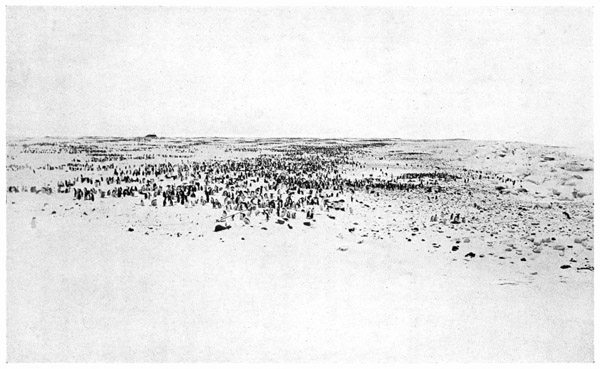
Fig. 11. THE ROOKERY BEGINNING TO FILL UP
(Page 18)
By the morning of October 19 there had been
a good many more arrivals, but the rookery was
not yet more than one-twentieth part full. All
the birds were fasting absolutely. Nest building
was now in full swing, and the whole place waking
up to activity. Most of the pebbles for the new
nests were being taken from old nests, but a great
deal of robbery went on nevertheless. Depredators
when caught were driven furiously away, and
occasionally chased for some distance, and it was
curious to see the difference in the appearance
between the fleeing thief and his pursuer. As the
former raced and ducked about among the nests,
doubling on his tracks, and trying by every means
to get lost in the crowd and so rid himself of
his pursuer, his feathers lay close back on his
skin, giving him a sleek look which made him
appear half the size of the irate nest-holder who
sought to catch him, with feathers ruffled in indignation.
This at first led me to think that the hens
were larger than the cocks, as it was generally the
hen who was at home, and the cock who was after
the stones, but later I found that sex makes
absolutely no difference in the size of the birds,
or indeed in their appearance at all, as seen by the
human eye. After mating, their behaviour as well
as various outward signs serve to distinguish male
from female. Besides this certain differences in
their habits, which I will describe in another
place, are to be noted.
The consciousness of guilt, however, always
makes a penguin smooth his feathers and look
small, whilst indignation has the opposite effect.
Often when observing a knoll crowded with
nesting penguins, I have seen an apparently under-sized
individual slipping quietly along among the
nests, and always by his subsequent proceedings he
has turned out to be a robber on the hunt for
his neighbours' stones. The others, too, seemed to
know it, and would have a peck at him as he passed
them.
At last he would find a hen seated unwarily
on her nest, slide up behind her, deftly and silently
grab a stone, and run off triumphantly with it
to his mate who was busily arranging her own
home. Time after time he would return to the
same spot, the poor depredated nest-holder being
quite oblivious of the fact that the side of her nest
which lay behind her was slowly but surely vanishing
stone by stone.
Here could be seen how much individual character
makes for success or failure in the efforts of the
penguins to produce and rear their offspring.
There are vigilant birds, always alert, who seem
never to get robbed or molested in any way: these
have big high nests, made with piles of stones.
Others are unwary and get huffed as a result.
There are a few even who, from weakness of
character, actually allow stronger natured and
more aggressive neighbours to rob them under
their very eyes.
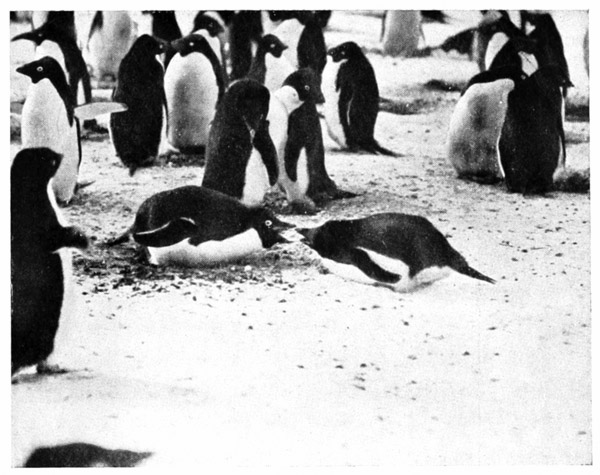
Fig. 12. “The Hens would keep up this Peck-pecking
hour after Hour”
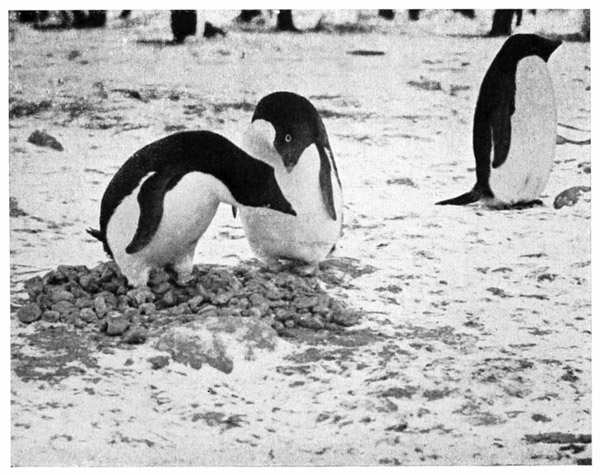
Fig. 13. An Affectionate Couple
(Page 26)
In speaking of the robbery which is such a
feature of the rookery during nest building, special
note must be made of the fact that violence is
never under any circumstances resorted to by the
thieves. When detected, these invariably beat a
retreat, and offer not the least resistance to the
drastic punishment they receive if they are caught
by their indignant pursuers. The only disputes
that ever take place over the question of property
are on the rare occasions when a bona-fide misunderstanding
arises over the possession of a nest.
These must be very rare indeed, as only on one
occasion have I seen such a quarrel take place.
The original nesting sites being, as I will show,
chosen by the hens, it is the lady, in every case,
who is the cause of the battle, and when she is
won her scoop goes with her to the victor.
As I grew to know these birds from continued
observation, it was surprising and interesting to
note how much they differed in character, though
the weaker-minded who would actually allow themselves
to be robbed, were few and far between, as
might be expected. Few, if any, of these ever
could succeed in hatching their young and winning
them through to the feathered stage.
When starting to make her nest, the usual procedure
is for the hen to squat on the ground for
some time, probably to thaw it, then working with
her claws to scratch away at the material beneath
her, shooting out the rubble behind her. As she
does this she shifts her position in a circular direction
until she has scraped out a round hollow.
Then the cock brings stones, performing journey
after journey, returning each time with one pebble
in his beak which he deposits in front of the hen
who places it in position.
Sometimes the hollow is lined with a neat pavement
of stones placed side by side, one layer deep,
on which the hen squats, afterwards building up
the sides around her. At other times the scoop
would be filled up indiscriminately by a heap of
pebbles on which the hen then sat, working herself
down into a hollow in the middle.
Individuals differ, not only in their building
methods, but also in the size of the stones they
select. Side by side may be seen a nest composed
wholly of very big stones, so large that it is a
matter for wonder how the birds can carry them,
and another nest of quite small stones. (Fig. 14.)
Different couples seem to vary much in character
or mood. Some can be seen quarrelling violently,
whilst others appear most affectionate, and the
tender politeness of some of these latter toward
one another is very pretty to see. (Fig. 13.)
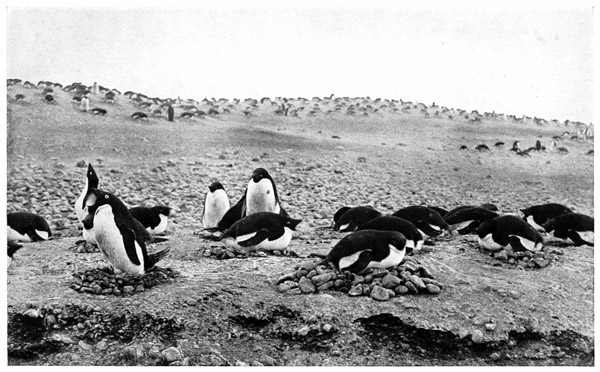
Fig. 14. “SIDE BY SIDE … NESTS OF VERY BIG STONES AND NESTS OF VERY SMALL STONES”
(Page 26)
I may here mention that the temperatures were
rising considerably by October 19, ranging about
zero F.
During October 20 the stream of arrivals was
incessant. Some mingled at once with the crowd,
others lay in batches on the sea-ice a few yards
short of the rookery, content to have got so far,
and evidently feeling the need for rest after their
long journey from the pack. The greater part of
this journey was doubtless performed by swimming,
as they crossed open water, but I think that much
of it must have been done on foot over many miles
of sea-ice, to account for the fatigue of many of them.
Their swimming I will describe later. On the
ice they have two modes of progression. The first
is simple walking. Their legs being very short,
their stride amounts at most to four inches.
Their rate of stepping averages about one hundred
and twenty steps per minute when on the march.
Their second mode of progression is “tobogganing.”
When wearied by walking or when the
surface is particularly suitable, they fall forward on
to their white breasts, smooth and shimmering with
a beautiful metallic lustre in the sunlight, and push
themselves along by alternate powerful little strokes
of their legs behind them.
When quietly on the march, both walking and
tobogganing produce the same rate of progression,
so that the string of arriving birds, tailing out in a
long line as far as the horizon, appears as a well-ordered
procession. I walked out a mile or so
along this line, standing for some time watching it
tail past me and taking the photographs with which
I have illustrated the scene. Most of the little
creatures seemed much out of breath, their wheezy
respiration being distinctly heard.
First would pass a string of them walking, then
a dozen or so tobogganing. (Fig. 15.) Suddenly
those that walked would flop on to their breasts
and start tobogganing, and conversely strings of
tobogganers would as suddenly pop up on to their
feet and start walking. In this way they relieved
the monotony of their march, and gave periodical
rest to different groups of muscles and nerve-centres.
The surface of the snow on the sea-ice varied
continually, and over any very smooth patches the
pedestrians almost invariably started to toboggan,
whilst over “bad going” they all had perforce to
walk.
Figs. 16, 17, 18 and 19 present some idea of
the procession of these thousands on thousands of
penguins as day after day they passed into the
rookery.
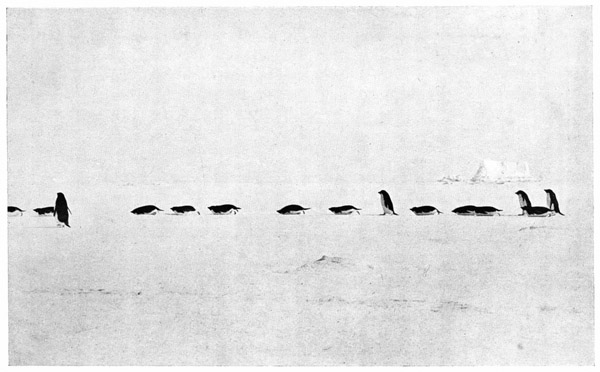
Fig. 15. ON THE MARCH TO THE ROOKERY OVER THE SEA-ICE.
SOME ARE WALKING AND SOME “TOBOGGANING”
(Page 28)
When tobogganing, turning to one side or the
other is done with one or more strokes of the
opposite flipper. When fleeing or chasing, both
flippers as well as both feet are used in propulsion,
and over most surfaces tobogganing is thus their
fastest mode of progression, but when going at full
tilt it is also the most exhausting, and after a short
spurt in this way they invariably return to the
walking position.
By October 20 many of the nests were complete,
and the hens sat in them, though no eggs were to
be seen yet. In the middle of one of the frozen
lakes rose a little island, well suited for nesting
except for the fact that later in the season, probably
about the time when the young chicks were
hatched, the lake would be thawed and the approach
to the island only to be accomplished through
about six inches or more of dirty water and ooze.
Until then, however, the surface of the lake would
remain frozen, and was at this time covered with
snow.
Not a penguin attempted to build its nest on
this island, though many passed it or walked over
it in crossing the lake. How did they realize that
later on they would get dirty every time they
journeyed to or from the spot?
Not far from this island another mound rose
from the lake, but this was connected with the
“mainland” by a narrow neck of guano-covered
pebbles. This mound was covered with nests,
showing that the birds understood this place could
always be reached over dry land. Surely this was
well worth remarking.
There was a part of the ice-foot on the south
side of the rookery where a track worn by many
ascending penguins could be seen, leading from the
sea-ice on to the beach. The place was steep and
the ice slippery, and, in fact, the track led straight
up a most difficult ascent. Not ten yards from
this well-worn track a perfectly easy slope led up
from the sea-ice to the rookery. The tracks in the
freshly fallen snow showed that only one penguin
had gone up this way. Presumably the first
arrival in that place had taken the difficult path,
and all subsequent arrivals blindly followed in his
tracks, whilst only one had had the good luck or
independence to choose the easier way.
On October 21 many thousands of penguins
arrived from the northerly direction, and poured
on to the beach in a continuous stream, the snaky
line of arrivals extending unbroken across the sea-ice
as far as the eye could see.

Fig. 16. PART OF THE LINE OF APPROACHING BIRDS, SEVERAL MILES IN LENGTH
(Page 28)
A great many now started to climb the heights
up the precipitous side of Cape Adare and to build
their nests as far as the summit, a height of some
1000 feet, although there was still room for many
thousand more down below. What could be their
object, considering the wearisome journeys they
would have to make to feed their young, it is
impossible to say. It might be the result of the
same spirit which made them spread out in little
scattered groups over the rookery when only a few
had arrived, and that they prefer wider room, only
putting up with the greater crowding which ensues
later as a necessary evil. There is, however, another
explanation which I will discuss in another place.
At 9 P.M. it was getting dusk, and the rookery
comparatively silent, although on some of the
knolls two or three birds might be seen still busily
working, toddling to and fro fetching stones. The
other thousands lay at rest, their white breasts flat
on the ground, and only their black beaks and
heads visible as they lay with their chins stretched
forward on the ground, whilst in place of the
massed discord of clamour heard during the day,
the separate voices of some of the busy ones
were distinct. A fine powdering of snow was
falling.
It would be difficult to estimate the number
of penguins that poured into the rookery during
the following day. There was no evidence that any
pairing had taken place on or before the march, and
the birds all had the appearance of being quite
independent.
Far away from the beach the line had become
thicker, and was no longer in single file, the
progress of the birds being slow and steady, but
when within half a mile or so from the beach,
excitement seemed to take possession of them, and
they would break into a run, hastening over the remaining
distance, the line now being a thin one,
with slight curves in it, each bird running, with
wide gait, and outstretched flippers working away
in unison with its little legs. In fact, the whole
air of the line at this time was that of a school-treat
arrived in sight of its playing-fields, and
breaking into a run in its eagerness to get there.
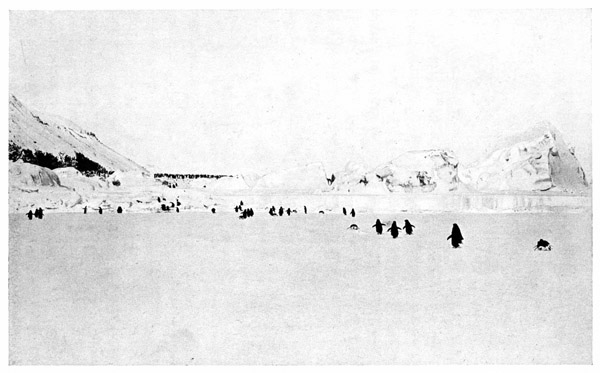
Fig. 17. ARRIVING AT THE ROOKERY
(Page 28)
Arrived at the rookery, and plunged suddenly
amidst the din of that squalling, fighting, struggling
crowd, the contrast with the dead silence and
loneliness of the pack-ice they had so recently left,
was as great a one as can well be imagined; yet
once there, the birds seemed collected and at home.
This was a matter of surprise to me then, but I
remember now my own sensations on arriving home
after my life in the Antarctic, and that I felt only
slightly the sudden return to the bustle of civilization.
Our presence among them made little or no
difference to the penguins. When we passed them
closely they would bridle up and swear or even
run at us and peck at our legs or batter them with
their flippers, but unless their nesting operations
were interfered with this attack was short-lived,
and the next moment the birds would seem to
forget our very existence. If I walked by the side
of a long, nest-covered ridge, a low growl arose
from every bird as I passed it, and the massed
sound, gathering in front and dying away behind
as I advanced, reminded me forcibly of the sound
of the crowds on the towing-path at the 'Varsity
boatrace as the crews pass up the river.
Walking actually among the nests, your temper
is tried sorely, as every bird within reach has
a peck at your legs, and occasionally a cock
attacks you bravely, battering you with his little
flippers in a manner ludicrous at first but aggravating
after a time, as the operation is painful and
severe enough to leave bruises behind it, and
naturally this begins to pall. The courage of
these little birds is most remarkable and admirable.
Our hut, being built on the rookery, could only
be approached through crowds of penguins. Those
that nested near us seemed quickly to become used
to us and to take less notice of us than those
farther off. One thing, however, terrified them
pitiably. We had to fetch ice for our water
from some stranded floes on the ice-foot, and
this we did in a little sledge. As we hauled
this rattling over the pebbly rookery it made
a good deal of noise, and in its path nests were
deserted, the occupants fleeing in the greatest confusion,
a clear road being left for the sledge, whilst
on either side a line of penguins was seen retreating
in the utmost terror. After about a minute,
they returned to their places and seemed to
forget the incident, but we were very sorry to
frighten them in this way, as we endeavoured to
live at peace with them and to molest them as little
as possible, and we feared that later on eggs might
be spilt from the nests and broken. As time went
on, those on the route of the sledge became
accustomed even to this, and we were able to
choose a course which cleared their nests.
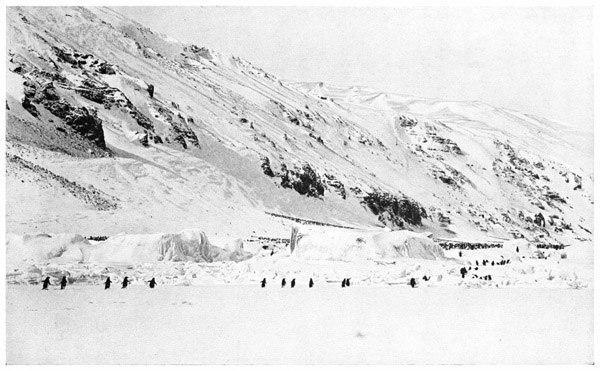
Fig. 18. ARRIVING AT THE ROOKERY. IN THE BACKGROUND IS THE CLIFF UP WHICH MANY OF THE BIRDS CLIMB TO MAKE THEIR NESTS AT THE SUMMIT
(Page 28)
Although squabbles and encounters had been
frequent since their arrival in any numbers, it now
became manifest that there were two very different
types of battle; first, the ordinary quarrelling consequent
on disputes over nests and the robbery of
stones from these, and secondly, the battles between
cocks who fought for the hens. These last were
more earnest and severe, and were carried to a
finish, whereas the first named rarely proceeded to
extremes.
In regard to the mating of the birds, the following
most interesting customs seemed to be prevalent.
The hen would establish herself on an old nest, or
in some cases scoop out a hollow in the ground and
sit in or by this, waiting for a mate to propose
himself. (Fig. 26.) She would not attempt to
build while she remained unmated. During the
first week of the nesting season, when plenty of
fresh arrivals were continually pouring into the
rookery, she did not have long to wait as a rule.
Later, when the rookery was getting filled up,
and only a few birds remained unmated in that
vast crowd of some three-quarters of a million, her
chances were not so good.
For example, on November 16 on a knoll thickly
populated by mated birds, many of which already
had eggs, a hen was observed to have scooped a
little hollow in the ground and to be sitting in this.
Day after day she sat on looking thinner and
sadder as time passed and making no attempt to
build her nest. At last, on November 27, she had
her reward, for I found that a cock had joined her,
and she was busily building her nest in the little
scoop she had made so long before, her husband
steadily working away to provide her with the
necessary pebbles. Her forlorn appearance of the
past ten days had entirely given place to an air of
occupation and happiness.
As time went on I became certain that invariably
pairing took place after arrival at the
rookery. On October 23 I went to the place where
the stream of arrivals was coming up the beach, and
presently followed a single bird, which I afterwards
found to be a cock, to see what it was going to do.
He threaded his way through nearly the whole
length of the rookery by himself, avoiding the
tenanted knolls where the nests were, by keeping
to the emptier hollows. About every hundred yards
or so he stopped, ruffled up his feathers, closed his
eyes for a moment, then “smoothed himself out”
and went on again, thus evidently struggling against
desire for sleep after his journey. As he progressed
he frequently poked his little head forward and from
side to side, peering up at the knolls, evidently in
search of something.
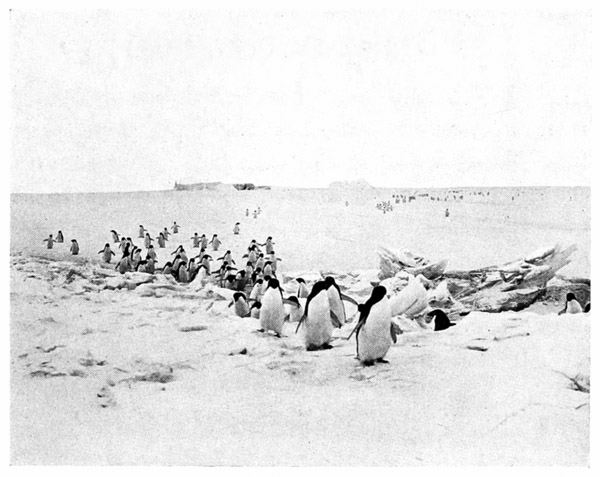
Fig. 19. Adélies arriving at the Rookery
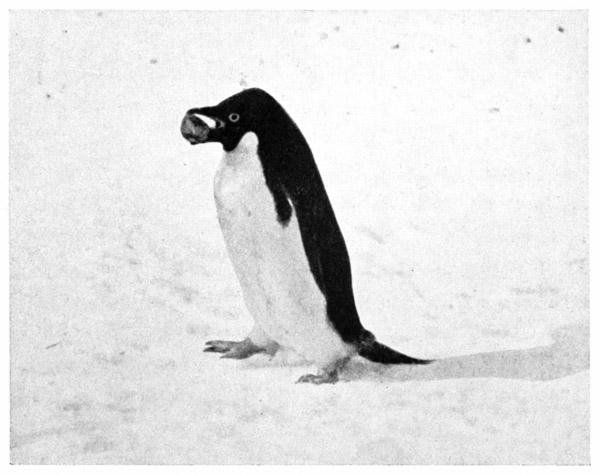
Fig. 20. A Cock carrying a Stone to his Nest
(Page 21)
Arrived at length at the south end of the
rookery, he appeared suddenly to make up his
mind, and boldly ascending a knoll which was well
tenanted and covered with nests, walked straight
up to one of these on which a hen sat. There was
a cock standing at her side, but my little friend
either did not see him or wished to ignore him
altogether. He stuck his beak into the frozen
ground in front of the nest, lifted up his head and
made as if to place an imaginary stone in front of
the hen, a most obvious piece of dumb show. The
hen took not the slightest notice nor did her mate.
My friend then turned and walked up to another
nest, a yard or so off, where another cock and hen
were. The cock flew at him immediately, and
after a short fight, in which each used his flippers
savagely, he was driven clean down the side of the
knoll away from the nests, the victorious cock
returning to his hen. The newcomer, with the
persistence which characterises his kind, came
straight back to the same nest and stood close by
it, soon ruffling his feathers and evidently settling
himself for a doze, but, I suppose, because he made
no further overtures the others took no notice of
him at all, as, overcome by sheer weariness, he
went to sleep and remained so until I was too cold
to await further developments. On my way back
to our hut I followed another cock for about thirty
yards, when he walked up to another couple at a
nest and gave battle to the cock. He, too, was
driven off after a short and decisive fight. Soon
there were many cocks on the war-path. Little
knots of them were to be seen about the rookery,
the lust of battle in them, watching and fighting
each other with desperate jealousy, and the later
the season advanced the more “bersac” they
became.
A typical scene I find described in my notes for
October 25 when I was out with my camera, and
I mention it as a type of the hundreds that were
proceeding simultaneously over the whole rockery,
and also because I was able to photograph different
stages of the proceedings as follows:
Fig. 22 shows a group of three cocks engaged
in bitter rivalry round a hen who is cowering in
her scoop in which she had been waiting as is their
custom. She appeared to be bewildered and
agitated by the desperate behaviour of the cocks.
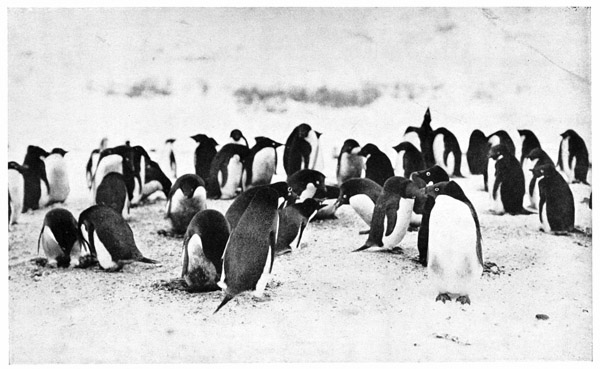
Fig. 21. SEVERAL INTERESTING THINGS ARE TAKING PLACE HERE
(Page 43)
On Fig. 23 a further development is depicted,
and two of the cocks are seen to be squaring up for
battle. Close behind and to the right of them are
seen (from left to right) the hen and the third cock,
who are watching to see the result of the contest,
and another hen cowering for protection against a
cock with whom she has become established.
Fig. 24 shows the two combatants hard at it,
using their weight as they lean their breasts against
one another, and rain in the blows with their powerful
flippers.
Fig. 25 shows the end of the fight, the victor
having rushed the vanquished cock before him out
of the crowd and on to a patch of snow on which,
as he was too brave to turn and run, he knocked
him down and gave him a terrible hammering.
When his conqueror left him at length, he lay for
some two minutes or so on the ground, his heaving
breast alone showing that he was alive, so completely
exhausted was he, but recovering himself at
length he arose and crawled away, a damaged flipper
hanging limply by his side, and he took no further
part in the proceedings. The victorious bird rushed
back up the side of the knoll, and immediately fought
the remaining cock, who had not moved from his
original position, putting him to flight, and chasing
him in and out of the crowd, the fugitive doubling
and twisting amongst it in a frantic endeavour to get
away, and I quickly lost sight of them.
Scenes of this kind became so common all over
the rookery, that the roar of battle and thuds of
blows could be heard continuously, and of the
hundreds of such fights, all plainly had their cause
in rivalry for the hens.
When starting to fight, the cocks sometimes peck
at each other with their beaks, but always they very
soon start to use their flippers, standing up to one another
and raining in the blows with such rapidity as
to make a sound which, in the words of Dr. Wilson,
resembles that of a boy running and dragging his
hoop-stick along an iron paling. Soon they start
“in-fighting,” in which position one bird fights right-handed,
the other left-handed; that is to say, one
leans his left breast against his opponent, swinging
in his blows with his right flippers, the other presenting
his right breast and using his left flipper. My
photographs of cocks fighting all show this plainly.
It is interesting to note that these birds, though
fighting with one flipper only, are ambidextrous.
Whilst battering one another with might and main
they use their weight at the same time, and as one
outlasts the other, he drives his vanquished opponent
before him over the ground, as a trained boxing
man, when “in-fighting” drives his exhausted
opponent round the ring.
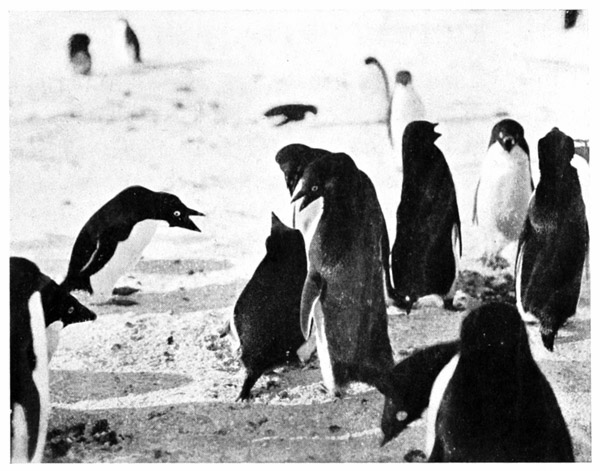
Fig. 22. Three Cocks in Rivalry
(See page 38)
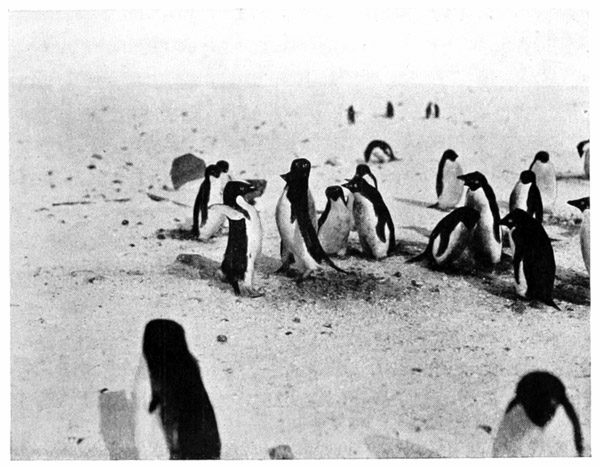
Fig. 23. Two of the Cocks squaring up for Battle
(See page 38)
Desperate as these encounters are, I don't think
one penguin ever kills another. In many cases
blood is drawn. I saw one with an eye put out,
and that side of its beak (the right side) clotted
with blood, whilst the crimson print of a blood-stained
flipper across a white breast was no uncommon
sight.
Hard as they can hit with their flippers, however,
they are also well protected by their feathers, and
being marvellously tough and enduring the end
of a hard fight merely finds the vanquished bird
prostrate with exhaustion and with most of the
breath beaten out of his little body. The victor is
invariably satisfied with this, and does not seek to
dispatch him with his beak.
It was very usual to see a little group of cocks
gathered together in the middle of one of the
knolls squabbling noisily. Sometimes half a dozen
would be lifting their raucous voices at one particular
bird, then they would separate into pairs,
squaring up to one another and emphasizing their
remarks from time to time by a few quick blows
from their flippers. It seemed that each was indignant
with the others for coming and spoiling his
chances with a coveted hen, and trying to get them
to depart before he went to her.
It was useless for either to attempt overtures
whilst the others were there, for the instant he did
so, he would be set upon and a desperate fight
begin. Usually, as in the case I described above,
one of the little crowd would suddenly “see red”
and sail into an opponent with desperate energy,
invariably driving him in the first rush down the
side of the knoll to the open space surrounding it,
where the fight would be fought out, the victor returning
to the others, until by his prowess and force
of character, he would rid himself of them all. Then
came his overtures to the hen. He would, as a
rule, pick up a stone and lay it in front of her if she
were sitting in her “scoop,” or if she were standing
by it he might himself squat in it. She might take
to him kindly, or, as often happened, peck him
furiously. To this he would submit tamely, hunching
up his feathers and shutting his eyes while she
pecked him cruelly. Generally after a little of this
she would become appeased. He would rise to his
feet, and in the prettiest manner edge up to her,
gracefully arch his neck, and with soft guttural
sounds pacify her and make love to her.
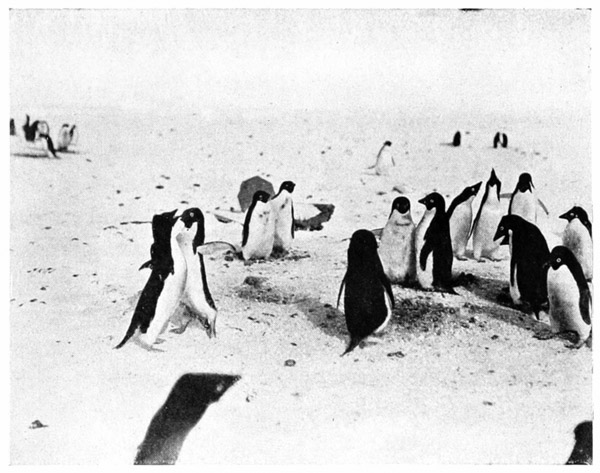
Fig. 24. “Hard at it”
(See page 39)
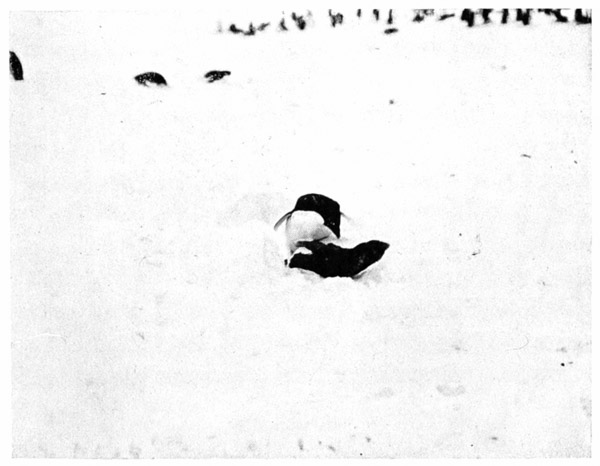
Fig. 25. The End of the Battle
(Page 39)
Both perhaps would then assume the “ecstatic”
attitude, rocking their necks from side to side as
they faced one another (Fig. 26), and after this a
perfect understanding would seem to grow up
between them, and the solemn compact was made.
It is difficult to convey in words the daintiness
of this pretty little scene. I saw it enacted many
dozens of times, and it was wonderful to watch one
of these hardy little cocks pacifying a fractious hen
by the perfect grace of his manners.
Fig. 21 is particularly instructive. In the centre
of the picture a group of cocks are quarrelling, and
on the left-hand side three unmated hens can
be seen sitting in their scoops, whilst two of them
(the two in front) are receiving overtures from two
of the cocks who are making the most of their time
whilst the others are fighting. On the right-hand
side another cock is seen proposing himself to a
fourth hen who seems to be meeting his overtures
with the usual show of reluctance.
Although for the later arrivals a good deal
of fighting was necessary before a mate could
be secured, it seemed that some got the matter
fixed up without any difficulty at all, especially
during the earlier days when only a few birds were
scattered widely over the rookery. Later, the
cocks seemed to watch one another jealously, and
to hunt in little batches in consequence. (Figs.
27, 28, and 29.)
From the particulars I have just given it is also
evident that a wife and home once obtained could
only be kept by dint of further battling and
constant vigilance during the first stages of
domesticity, when thousands of lusty cocks were
pouring into the rookery, and it was not unusual to
see a strange cock paying court to a mated hen
in the absence of her husband until he returned
to drive away the interloper, but I do not think
that this ever occurred after the eggs had come and
the regular family life begun, couples after this
being perfectly faithful to one another.
The instance I have given of a newly arrived
cock by dumb show pretending to take a stone
and place it before a mated hen, is typical of
the sort of first overture one sees, though more
frequently an actual stone was tendered. While on
this subject I had better mention a most interesting
thing which occurred to one of my companions.
One day as he was sitting quietly on some shingle
near the ice-foot, a penguin approached him,
and after eyeing him for a little, walked right up
to him and nibbled gently at one of the legs of
his wind-proof trousers. Then it walked away,
picked up a pebble, and came back with it, dropping
it on the ground by his side. The only explanation
of this occurrence seems to be that the tendering of
the stone was meant as an overture of friendship.
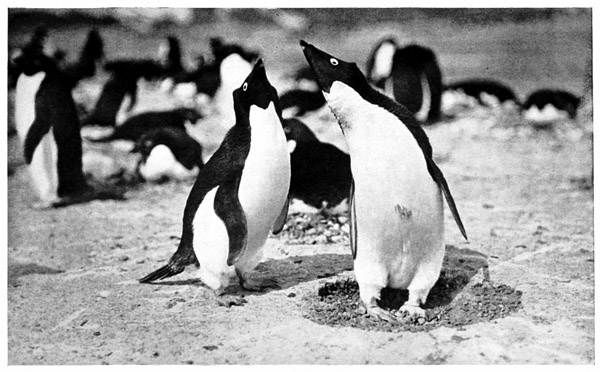
Fig. 26. THE PROPOSAL. (NOTE THE HEN IN HER SCOOP)
(Pages 35 and 43)
On October 26 there was no abatement in the
stream of arrivals. The cock-fighting continued,
and many of them, temporarily disabled, were to
be seen moping about the rookery, smeared with
blood and guano. Often a hen would join in when
two cocks were fighting, occasionally going first for
one and then the other, but I never to my knowledge
saw a cock retaliate on a hen.
Once I saw two cocks fighting, and a hen taking
the part of one of the cocks, the pair of them gave
the other a fearful hammering, the hen using
her bill savagely as well as her flippers. Completely
knocked out and gasping for breath he got away at
last, only to meet another cock who fought him
and easily beat him. When this one had gone
a third came, and the poor victim with a courage
truly noble was squaring himself up with his
last spark of energy, when I interfered and drove
away his enemy.
The nests on most of the knolls soon became so
crowded that their occupants, by stretching out
their necks, could reach their neighbours without
getting up. As every hen appeared to hate her
neighbour they would peck-peck at one another
hour after hour, in the manner seen in my
photograph,(3) till their mouths and heads became
terribly sore. Occasionally they would desist, shake
their heads apparently from pain, then at it again.
In various places through the course of these
pages, reference is made to the “ecstatic” attitude
of the penguins. This antic is gone through by
both sexes and at various times, though much more
frequently during the actual breeding season. The
bird rears its body upward and stretching up its
neck in a perpendicular line, discharges a volley
of guttural sounds straight at the unresponding
heavens. At the same time the clonic movements
of its syrinx or “sound box” distinctly can be seen
going on in its throat. Why it does this I have
never been able to make out, but it appears to be
thrown into this ecstasy when it is pleased; in fact,
the zoologist of the “Pourquoi Pas” expedition
termed it the “Chant de satisfaction.” I suppose
it may be likened to the crowing of a cock or the
braying of an ass. When one bird of a pair starts
to perform in this way, the other usually starts at
once to pacify it. Very many times I saw this
scene enacted when nesting was in progress. The
two might be squatting by the nest when one would
arise to assume the “ecstatic” attitude and make
the guttural sounds in its syrinx. Immediately
the other would get close up to it and make the
following noise in a soft soothing tone:

A-ah
Always and immediately this caused the musician
to subside and settle itself down again.
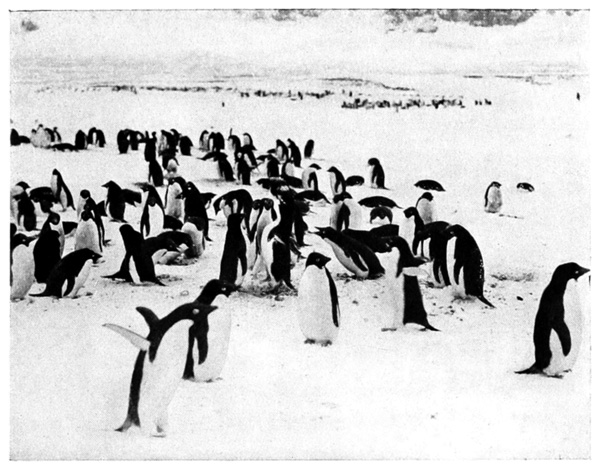
Fig. 27. Cocks fighting for Hens
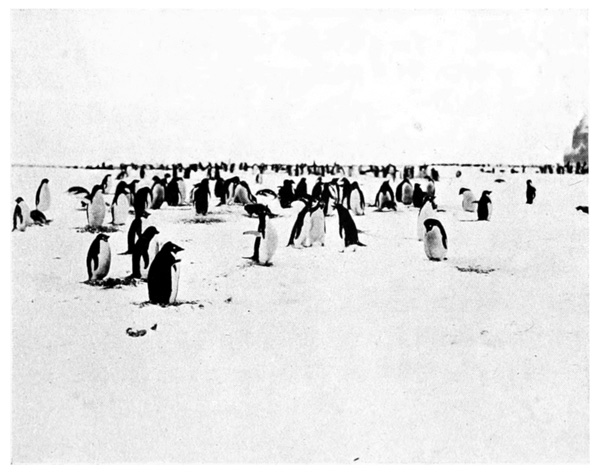
Fig. 28. Cocks fighting for Hens
(Page 44)
The King penguin at the Zoological Gardens,
whose sex is unknown, throws itself into the
ecstatic attitude and sings a sort of song when its
keeper strokes its neck. The blackfooted penguins
never do it, though they breed several times a year.
Figs. 26 and 32 show Adélies in ecstatic attitude.
To-day about a dozen skua gulls (Megalestris
Makormiki) appeared for the first time. They did
not start to nest, but sat on the sea-ice with a
group of penguins, in apparent amity. A few
occasionally flew about over the rookery.
On October 27 though the stream of arrivals
continued there were wide gaps in it. It appeared
to be thinning. For an hour in the forenoon it
stopped altogether, and at the end of this time a
storm of wind from the south struck us and continued
for another hour with thick drift. Probably
clear of Cape Adare the wind had been blowing
before it reached us, and had stopped the birds'
progress across the ice.
During the storm the rookery was completely
silenced, most of the birds lying with their heads to
the wind. A good many skuas arrived that day.
Some chips of white, glistening quartz had been
thrown down by our hut door recently, and later I
found two of these chips in a nest about thirty
yards away, showing up brightly against the black
basalt of which all the pebbles on the rookery were
composed.
As a rule the penguins were careful to select
rounded stones for their nests, but these fragments
of quartz were jagged and uncomfortable, and most
unsuitable for nest building. Thus it was evidently
the brightness of the stones which attracted them.
Whilst I looked on, the owners of the pieces of
quartz were wrangling with their neighbours, and
a penguin in a nest behind shot out its beak and
stole one of the pieces, placing it in its own nest.
I had brought Campbell out to show him the pieces
of quartz, and he witnessed the last incident
with me.
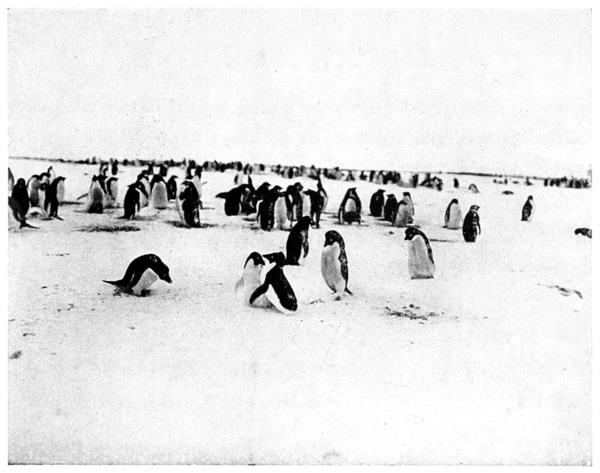
Fig. 29. Cocks fighting for Hens
(Page 44)
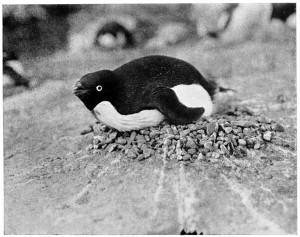
Fig. 30. Penguin on Nest
I may here mention an experiment I tried some
days later. I painted some pebbles a bright red
and had others covered with bright green cotton
material as I had no other coloured paint. Mixing
a handful of these coloured stones together I placed
them in a little heap amongst natural black ones
near a nest-covered knoll. Returning in a few
hours I found nearly all the red stones and one or
two of the green ones gone, and later found them
in nests. Later still, all the red ones had disappeared,
and last of all the green ones. I traced
nearly all these to nests, and found a few days later
that, like the pieces of white quartz, they were
being stolen from nest to nest and thus slowly
being distributed in different directions. At other
times I saw pieces of tin, pieces of glass, half a
stick of chocolate, and the head of a bright metal
teaspoon in different nests near our hut, the articles
evidently having been taken from our scrap-heap.
Thus it is evident that penguins like bright colours
and prefer red to green, as instanced by the selection
of the coloured pebbles. I am sorry that I
did not carry these colour tests further.
During October 29 the stream of arrivals was
undiminished, but the next day it slackened considerably,
and during the next two days stopped
altogether, all the rising ground of the rookery now
being literally crammed full with nests, several
thousands of them being scattered up the slopes of
Cape Adare to a height of a thousand feet.
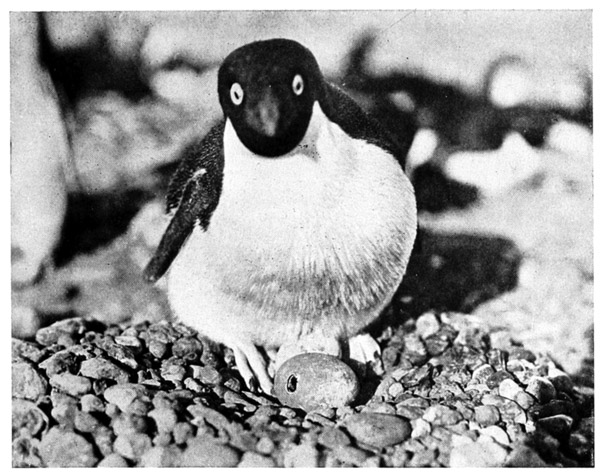
Fig. 31. Showing the Position of the Two Eggs
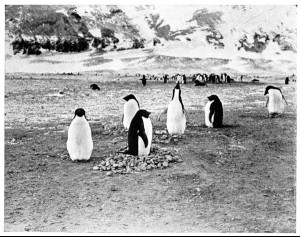
Fig. 32. An Adélie in “Ecstatic” Attitude
(Page 47)
PART II
DOMESTIC LIFE OF THE ADÉLIE PENGUIN
Laying and incubation of the eggs : The Adélies'
habits in the water : Their games : Care of the young :
The later development of their social system.
On November 3 several eggs were found, and on
the 4th these were beginning to be plentiful in
places, though many of the colonies had not yet
started to lay.
Let me here call attention to the fact that up to
now not a single bird out of all those thousands
had left the rookery once it had entered it. Consequently
not a single bird had taken food of any
description during all the most strenuous part of
the breeding season, and as they did not start to
feed till November 8 thousands had to my knowledge
fasted for no fewer than twenty-seven days.
Now of all the days of the year these twenty-seven
are certainly the most trying during the life of the
Adélie.
With the exception, in some cases, of a few
hours immediately after arrival (and I believe the
later arrivals could not afford themselves even this
short respite) constant vigilance had been maintained;
battle after battle had been fought; some
had been nearly killed in savage encounters, recovered,
fought again and again with varying
fortune. They had mated at last, built their nests,
procreated their species, and, in short, met the
severest trials that Nature can inflict upon mind
and body, and at the end of it, though in many
cases blood-stained and in all caked and bedraggled
with mire, they were as active and as brave as ever.
When one egg had been laid the hen still sat on
the nest. The egg had to be continually warmed,
and as the temperature was well below freezing-point,
exposure would mean the death of the
embryo.
In order to determine the period between the
laying of the two eggs, I numbered seven nests
with wooden pegs, writing on the pegs the date on
which each egg was laid. The result obtained is
shown on page 53.
The average interval in the four cases where two
eggs were laid being 3·5 days.
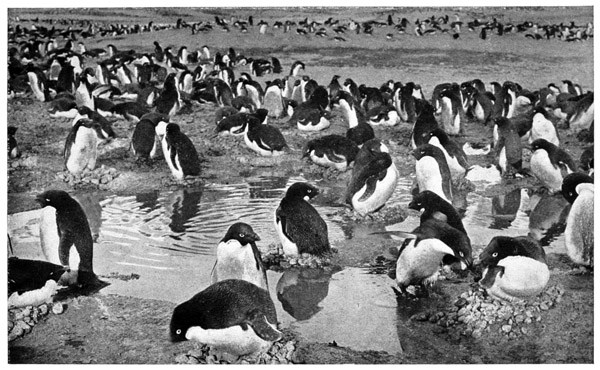
Fig. 33. Floods
(Page 66)
No. 7 nest was that of the hen which I mentioned
as having waited for so long for a mate,
and the lateness of the date on which the first
egg appeared may have resulted in there being
no other.
| Date of appearance of first egg | Date of appearance of second egg | Interval | |
|---|---|---|---|
| No. 1 nest | Nov. 14 | — | Only 1 laid |
| No. 2 nest | Nov. 13 | Nov. 16 | 3 days |
| No. 3 nest | Nov. 14 | Nov. 17 | 3 days |
| No. 4 nest | |||
| No. 5 nest | Nov. 12 | Nov. 16 | 4 days |
| No. 6 nest | Nov. 8 | Nov. 12 | 4 days |
| No. 7 nest | Nov. 24 | — | Only 1 laid |
The only notes I have on the incubation period
are that the first chick appeared in No. 5 nest on
December 19 (incubation period thirty-seven days)
and in No. 7 nest on December 28 (incubation
period thirty-four days).
The skuas had increased considerably in numbers
by November 4, and frequently came to the scrap-heap
outside our hut. Here were many frozen
carcasses of penguins which we had thrown there
after the breasts had been removed for food during
the past winter. The skuas picked the bones quite
clean of flesh, so that the skeletons lay white under
the skins, and it was remarkable to what distances
they sometimes carried the carcasses, which weighed
considerably more than the skuas themselves. I
found some of these bodies over five hundred yards
away.
A perpetual feud was carried on between the
penguins and the skuas. The latter birds come to
the south in the summer, and make their nests
close to, and in some cases actually among, those of
the penguins, and during the breeding time live
almost entirely on the eggs, and later, on the chicks.
They never attack the adult penguins, who run at
them and drive them away when they light within
reach, but as the skuas can take to the wing and
the penguins cannot, no pursuit is possible.

Fig. 34. Flooded
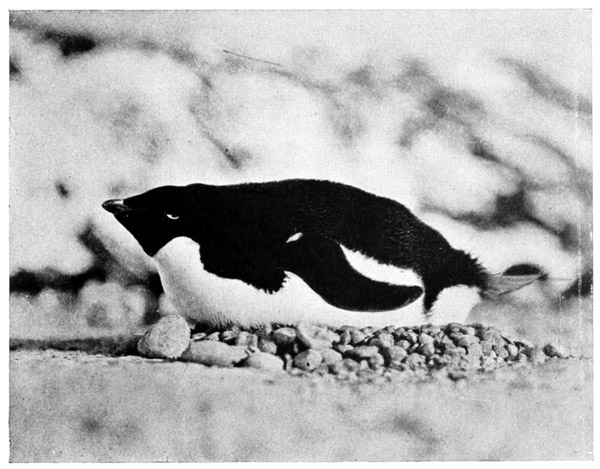
Fig. 35. A Nest with Stones of Mixed Sizes
The skuas fly about over the rookery, keeping only
a few yards from the ground, and should one of them
see a nest vacated and the eggs exposed, if only for
a few seconds, it swoops at this, and with scarcely
a pause in its flight, picks up an egg in its beak
and carries it to an open space on the ground, there
to devour the contents. Here then was another
need for constant vigilance, and so daring did the
skuas become, that often when a penguin sat on
a nest carelessly, so as to leave one of the eggs
protruding from under it, a lightning dash from a
skua would result in the egg being borne triumphantly
away.
The bitterness of the penguins' hatred of the skuas
was well shown in the neighbourhood of our scrap-heap.
None of the food thrown out on to this heap
was of the least use to the penguins, but we noticed
after a time that almost always there were one or
more penguins there, keeping guard against the
skuas, and doing their utmost to prevent them from
getting the food, and never allowing them to light
on the heap for more than a few seconds at a time.
In fact, a constant feature of this heap was the
sentry penguin, darting hither and thither, aiming
savage pecks at the skuas, which would then rise a
yard or two into the air out of reach, the penguin
squalling in its anger at being unable to follow its
enemy. At this juncture the penguin would imitate
the flying motion with its flappers, seeming instinctively
to attempt to mount into the air, as its
remote ancestors doubtlessly did, before their wings
had adapted themselves solely to swimming.
Close to the scrap-heap there was a large knoll
crowded with penguins' nests, and it was this knoll
that provided the sentries. Very rarely did one of
these leave the heap until another came to relieve
it as long as there were skuas about, but when the
skuas went the penguins left it too. When the
skuas returned, however, and without the lapse of
a few seconds, a penguin would be seen to detach itself
from the knoll and run to guard the heap. That
some primitive understanding on this matter existed
among the penguins seems to me probable, because
whilst there were generally one or two guarding
the heap, there was never a crowd, the rest of the
knoll seeming quite satisfied as long as one of
their number remained on guard.
In describing the Cape Adare rookery I mentioned
the fact that the pebbles entering into the
formation of the beach are basaltic, and therefore of
a dead black shade. The result of this is that as
the sun's altitude increases, heat is absorbed readily
by the black rock, through that clear atmosphere,
and the snow upon it rapidly melts.
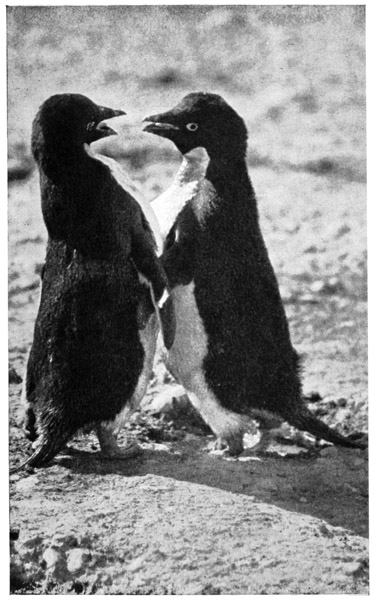
Fig. 36. “HOUR AFTER HOUR, DURING THE WHOLE DAY, THEY FOUGHT AGAIN AND AGAIN”
(Page 68)
For a long time the penguins at their nests had
satisfied their thirst by eating the snow near them,
but as this disappeared, they suffered greatly, as
was made evident by the way they lay with beaks
open and tongues exposed between them. (Fig. 30.)
As time went on the cocks started to make
short journeys to the drifts which still remained in
order to quench their thirst, but the hens stuck
manfully, or rather “henfully” to their posts,
though some of them seemed much distressed.
Later, those cocks which had nested in the centre
of the rookery had quite long journeys to make in
order to find drifts, a very popular resort being that
which had formed in the lee of our hut, and all day
streams of them came here to gobble snow. Once
a cock was seen to take a lump of snow in his beak
and carry it to his mate on the nest, who ate it.
Mr. Priestley tells me that when he was at Cape
Royds in 1908 he saw cocks taking snow to hens
on their nests. This procedure would seem to be
different to the parental instinct which governs the
feeding of the young, and it seemed to show that
the cock realized that the hen must be thirsty and
in need of the snow, and kept this fact in mind
when he was away from her. Another point to
note is that the occurrence was a very rare and, in
fact, exceptional one.
When conditions arose which were new to their
experience the penguins seemed utterly unable to
grasp them.
As an example of this, we had rigged a guide
rope from our hut to the meteorological screen,
about fifty yards away, to guide us during blizzards.
This rope, which was supported by poles driven
into the ground, sagged in one place till it nearly
touched the ground. At frequent intervals, penguins
on their way past the hut were brought to a
standstill by running their breasts into this sagged
rope, and each bird as it was caught invariably
went through the same ridiculous procedure. First
it would push hard against the rope, then finding
this of no avail, back a few steps, walk up to it
again and have another push, repeating the process
several times. After this, instead of going a few
feet further along where it could easily walk under
the rope, in ninety per cent. of cases it would turn,
and by a wide detour walk right round the hut the
other way, evidently convinced that some unknown
obstacle completely barred its passage on that side.
This spectacle was a continual source of amusement
to us as it went on all day and every day for
some time.

Fig. 37. A Nest on a Rock
(See page 71)

Fig. 38. “One after another, the rest of the Party followed him”
(Page 75)
As penguins' eggs are very good to eat and a
great luxury, as well as being beneficial to men
living under Antarctic conditions, we collected a
large number, which we stowed away to freeze.
To collect these eggs we used to set off, carrying
a bucket, and walk through the knolls. As we
picked our way, carefully placing our feet in the
narrow spaces between the nests, we were savagely
pecked about the legs, as in most positions at
least, these birds could reach us without even leaving
the nest, whilst very often the mates standing near
them would sail in at us, raining in blows with
their flippers with the rapidity of a maxim gun.
To search for eggs it was necessary to lift up the
occupant of each nest and look beneath her. If
she were tackled from front or flank this was a
painful and difficult business, as she drove at the
intruder's hands with powerful strokes of her sharp
beak, but we found that the best way to set about
the matter was to dangle a fur mit in front of
her with one hand, and when she seized this
quickly slip the other behind her, lifting her nether
regions from the nest, and at the same time pushing
her gently forward. Immediately she would
drop the fur mit, and sticking her beak into the
ground push herself backward with a determined
effort to stay on the nest. So long as the pressure
from behind was kept up she would keep her beak
firmly fixed in the ground, and could be robbed at
will.
The egg abstracted, she was then left in peace,
on which she would rise to her feet, look under her
for the egg and, finding that it was gone, ruffle her
feathers, and, trembling with indignation, look
round for the robber, seemingly quite unable to
realize that we were the guilty ones. This is
typical of the Adélie's attitude towards us. We
are beyond their comprehension, and fear of us,
anger at us, curiosity over us, although frequently
shown, are displayed only for a fleeting moment.
In a few minutes she might forget about the
incident altogether and quietly resume her position
on the empty nest, but very often she would
violently attack any other bird who might happen
to be standing near, and thus as we filled our
buckets we left a line of altercation in our wake.
This, however, was not long lived, and affairs soon
settled down to their normal state, and I believe
that in about one minute the affair was completely
forgotten. The penguin, indeed, is in its nature
the embodiment of all that man should be when he
explores the Antarctic regions, ever acting on the
principle that it is of no use to worry over spilt
milk.

Fig. 39. A JOY RIDE
(Page 77)
The comparative size of the penguin's egg is
shown in some of my photographs. Ninety-six
eggs averaged 4·56 ounces apiece. They vary in
size from about 6·45 cm. to 7·2 cm. in length, and
from 5·0 cm. to 5·5 cm. in breadth, on an average.
Both ends are nearly equally rounded, and of a white
chalky texture without, and green within. This
green colour is plainly shown by transmitted light.
When the two have been laid the sitting bird
places them one in front of the other. The rearmost
egg is tucked up on the outspread feet, the
foremost lies on the ground, and is covered by the
belly of the bird as it lies forward upon it. (Fig. 31.)
By many of the birds a strong inclination to
burrow was displayed, and they seemed very fond
of delving in the soft shingle ledges that were to be
found on some parts of the beach. They did this
ostensibly to get small stones for their nests, but
certainly burrowed deeper than they need have
done, and occasionally squatted for some time in
little caves that they made in this way. I noticed
the same thing in the drifts when they went to eat
snow, and thought at times that they were going
to make underground nests, but they never did so,
though some of the little shingle caves would have
made ideal nesting sites.
By November 7, though many nests were still
without eggs, a large number now contained two,
and their owners started, turn and turn about, to
go to the open water leads about a third of a mile
distant to feed, and as a result of this a change
began gradually to come over the face of the
rookery. Hitherto the whole ground in the neighbourhood
of the nests had been stained a bright
green. This was due to the fasting birds continually
dropping their watery, bile-stained excreta upon it.
(The gall of penguins is bright green.) These
excreta practically contained no solid matter excepting
epithelial cells and salts.
The nests themselves are never fouled, the
excreta being squirted clear of them for a distance
of a foot or more, so that each nest has the appearance
of a flower with bright green petals radiating
from its centre. Some of the photographs show
this well, especially Fig. 30. Even when the
chicks have come and are being sat upon by the
parents, this still holds good, because they lie with
their heads under the old bird's belly and their
hindquarters just presenting themselves, so that
they may add their little decorative offerings, petal
by petal! Now that the birds were going to feed,
the watery-green stains upon the ground gave
place to the characteristic bright brick-red guano,
resulting from their feeding on the shrimp-like
euphausia in the sea; and the colour of the whole
rookery was changed in a few days, though this
was first noticeable, of course, in the region of
those knolls which had been occupied first, and
which were now settled down to the peaceable and
regular family life which was to last until the chicks
had grown.
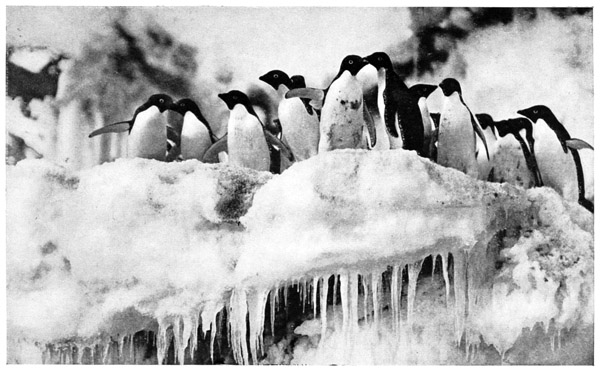
Fig. 40. A KNOT OF PENGUINS ON THE ICE-FOOT
(Page 77)
As this family life became established, law and
order reigned to some extent, and there was a
distinct tendency to preserve it, noticeably on those
knolls which had so settled down, and I think the
following most surprising incident bears evidence
of what I have said. I quote word for word from
my notes on November 24, 1911:
“This afternoon I saw two cocks (probably)
engaged in a very fierce fight, which lasted a good
three minutes. They were fighting with flippers
and bills, one of them being particularly clever with
the latter, frequently seizing and holding his opponent
just behind the right eye whilst he battered
him with his flippers.
“After a couple of minutes, during which each
had the other down on the ground several times,
three or four other penguins ran up and apparently
tried to stop the fight. This is the only construction
I can put on their behaviour, as time after time
they kept running in when the two combatants
clinched, pushing their breasts in between them,
but making no attempt to fight themselves, whilst
their more collected appearance and smooth feathers
were in marked contrast to the angry attitudes of
the combatants.
“The fight, which had started on the outskirts
of a knoll crowded with nests, soon edged away to
the space outside, and it was here that I (and
Campbell, who was with me) saw the other penguins
try to stop it. The last minute was a very
fierce and vindictive ‘mill,’ both fighting with all
their might, and ended in one of them trying to
toboggan away from his opponent; but he was too
exhausted to get any pace on, so that just as he
got into the crowd again he was caught, and both
fought for a few seconds more, when the apparent
victor suddenly stopped and ran away. The other
picked himself up and made his way rapidly among
the nests, evidently searching for one in particular.
“Following him, I saw him run up to a nest
near the place where the fight had begun. There
was a solitary penguin waiting by this nest, which
was evidently new and not yet completed, and
without eggs. The cock I had followed, ruffled
and battered with battle, ran up to the waiting bird,
and the usual side-to-side chatter in the ecstatic
attitude began and continued for half a minute, after
which each became calmer, and I left them apparently
reconciled and arranging stones in the nest.
“This incident was after the usual nature of a
dispute between two mates for a hen, but the pacific
interference of the other birds was quite new to
my experience. That it was pacific I am quite
convinced, and Campbell agreed with me that there
was no doubt of it. All the nests round about
had eggs under incubation, and the pair in question
must have been newcomers.”
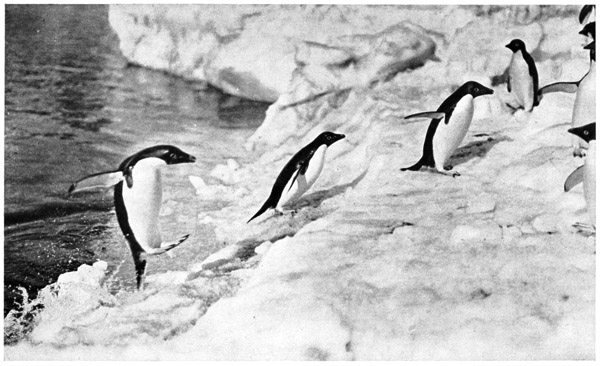
Fig. 41. AN ADÉLIE LEAPING FROM THE WATER
(Page 82)
On returning home I was glad to find that Mr.
Bernacchi, who landed at Cape Adare with the
“Southern Cross” expedition, says in his account
(p. 131) that he also saw penguins interfering and
trying to stop others from fighting.
Owing to our having several snowfalls without
wind, and to the action of the sun on the black
rock, which I have mentioned already, the rookery
became a mass of slush in many places, and in some
of the lower-lying parts actually flooded. In some
of these low-lying situations penguins had unwarily
made their nests, and there was one particular little
colony near our hut which was threatened with total
extinction from the accumulation of thaw water.
As this trickled down from the higher ground
around them, the occupants of the flooded ground
exerted all their energies to avert this calamity, and
from each nest one of its tenants could be seen
making journey after journey for pebbles, which it
brought to the one sitting on the nest, who placed
stone after stone in position, so that as the water
rose the little castle grew higher and higher and
kept the eggs dry. One nest in particular I noticed
which was as yet a foot or so clear of the water and
on dry ground; but whilst the hen sat on this,
the cock was working most energetically in anticipation
of what was going to happen, and for hours
journeyed to and from the nest, each time wading
across the little lake to the other side, where he was
getting the stones.
This scene, which I photographed, is depicted
on Fig. 33. In the right-hand corner of the
picture the cock is seen in the act of delivering
another stone to the hen who is waiting to receive
it, whilst some of the nests are actually surrounded
by water. Fig. 34 shows another nest, rising like
a little island from a thaw pool, the eggs being
only just above water.
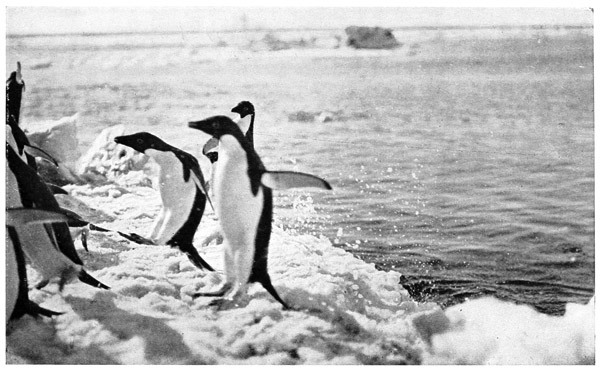
Fig. 42. ADÉLIE LEAPING FROM THE WATER (THIS BIRD JUMPED 4 FEET HIGH AND 10 FEET LONG)
(Page 82)
Some time ago I mentioned that there were
penguins of weak individuality who allowed others
to rob them of their stones, and this was in some
cases very noticeable on the flooded ground, and
there were one or two nests here which had been
almost entirely removed by thieving neighbours.
To quote again from my notes.
“November 10. This evening I saw a hen
penguin trying to sit on a nest with two eggs.
The nest had no stones, and was scooped deeply
in the ground in a slush of melting snow, so that
the eggs were nearly covered with water. The
poor hen stood in the water and kept trying to
squat down on the eggs, but each time she did so,
sat in the water and had to get up again. She
was shivering with cold and all bedraggled.
“I took the two eggs out of the nest, and
Browning and I collected a heap of stones (partly
from her richer neighbours!) and built the nest
well up above the water. Then I replaced the
eggs, and the hen at once gladly sat on them,
put them in position, and was busily engaged in
arranging the new stones round her when we left.”
One day, when the season was well advanced, I
saw a violent altercation taking place between two
penguins, one of which was in possession of a nest
in a somewhat isolated position. The other
evidently was doing his utmost to capture the
nest, as whenever he got the other off, he stood
on it. There were scarcely any stones in the nest,
which contained one egg. I think from the way
they fought that both were cocks.
For two reasons I make special mention of the
occurrence, first, because of all the fights I ever
saw this was the longest and most relentless, and,
secondly, because the nest being in such an isolated
position it seemed curious that there could be any
mistake about its ownership. Such, however,
seemed to be the case, and hour after hour, during
the whole day, they fought again and again.
After each bout of a few minutes both birds
became so exhausted that they sank panting to
the ground, evidently suffering from thirst and at
the limit of their endurance. Sometimes one
captured the nest, sometimes the other, but after
several hours of this, one of them began to show
signs of outlasting the other, and kept possession.
For long after this, however, the other returned
repeatedly to the attack.
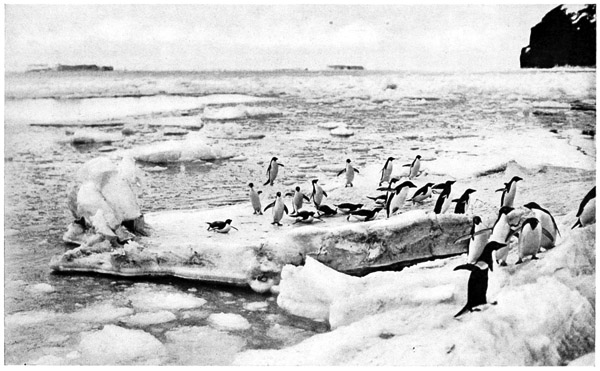
Fig. 43. JUMPING FROM THE WATER ON TO SLIPPERY ICE
(Page 82)
I fetched my camera and photographed the birds
as they fought (Fig. 36). As time went on, the
weaker bird took longer and longer intervals to
recover between his attacks, lying on his breast,
with his head on the snow and eyes half closed, so
that I thought he was going to die. Each time
he got to his feet and staggered at his enemy, the
latter rose from the nest and met him, only to
drive him back again. When I saw them at about
10 P.M. (it was perpetual daylight now) both were
lying down, the victor on the nest, the vanquished
about five yards off. The next day one bird remained
on the nest and the other had gone, and I
do not know what happened to him.
In the course of a walk through the rookery
considerable diversity in the choice of nesting sites
was to be noticed. The general tendency is for
the penguins to build their nests close together
(within a foot or two of one another) on the tops
of the rounded knolls, the lower levels being left
untenanted.
The most thickly populated districts were to be
found on the screes immediately below the cliffs.
These screes having been formed in the first instance
by the falling of fragments due to weathering
of the cliff, their substance is still added to,
little by little, as time goes on, and therefore many
are killed annually by falling rocks, as is mentioned
elsewhere, but weighing against this danger is the
advantage the cliff offers as a shelter from the
E.S.E. gales. The same applies to the nesting
sites up the cliff, but I am convinced that only the
love of climbing can account for the extraordinary
positions chosen by some of the birds. Some of
the nests are so difficult of access that their
occupants, on their way to them, may be seen
sliding backwards down the little glazed snow-slopes
several times before they accomplish the
ascent, whilst in other places they have to jump
from one foothold to another along the almost
perpendicular cliff.
Even up these heights a tendency to grouping is
seen, though there are a fair number of individuals
who, seeming to seek seclusion, make their nests
at some distance from the others. I noticed this
in some places along the shore, too, where solitary
nests were to be seen on isolated patches of
shingle.
When I visited Cape Royds in 1911 I found
a couple nesting alone in a cove known as “Black
Sand Beach,” some half mile from the rookery
there. Such isolation as this, however, is very
unusual, and was quite a departure from the
regular custom of the species.
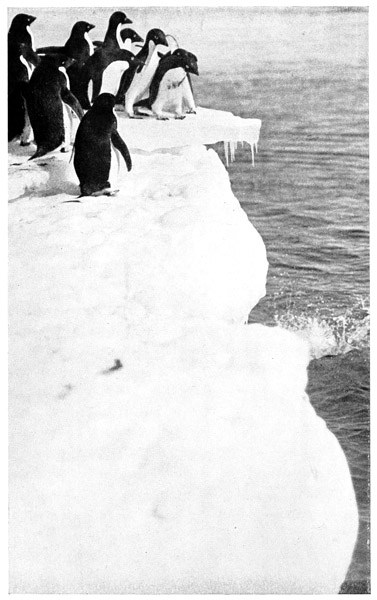
Fig. 44. “WHEN THEY SUCCEEDED IN PUSHING ONE OF THEIR NUMBER OVER, ALL WOULD CRANE THEIR NECKS OVER THE EDGE”
(Page 83)
In some places at Cape Adare, large rocks some
two or three feet in height stood about the rookery.
Whenever the summit of one of these was accessible,
a pair built their nest upon it,(4) though how
they managed to keep up there during the gales
was a matter for wonder, but the proud possessors
of the castle evidently had a delight in their lofty
position. One nest had been made on an old
packing-case left by the expedition which wintered
there in 1894, and several nested among the weathering
bones of the seals that had died on the beach.
Although the greatest care had been taken
by nearly all in the choice of sites that would be on
dry ground when the thaw came later in the
season, yet a few hens had gone to the other
extreme, and with greatest stupidity chosen their
site right down in the hollows where they were
absolutely certain to be flooded later on. These
stupid ones are thus prevented from rearing their
young, and so selection keeps the wiser for future
generations, and eliminates the less intelligent from
the community, though perhaps some of these learn
by experience, and next year use more discrimination
in choosing their nesting place.
Some of the colonies—in fact, most of them—were
orderly and well arranged, and later in the
season distinctly peaceful. Others, however, presented
a less respectable appearance. There was
one in particular, close to our hut, which could
only be described as a slum of the meanest description.
All through the season there was more
fighting in this colony than anywhere else, and
so remarkable was this, that we christened the
locality “Casey's Court” and the name stuck
for the rest of the year.
The nests had fewer stones than elsewhere,
and were more untidily made, and when the eggs
came, owing to the constant fighting that went on,
most of them got spilt from the nests or broken,
and very few chicks were hatched in consequence,
the mortality among them also being so great that
of the whole colony of some hundred nests, I
do not think more than forty or fifty chicks at
most reached maturity. The explanation of this
state of things lay, I believe, in the fact that
our hut and its curtilage deflected the stream
of penguins on their way past the spot from the
water to the back of the rookery, so that a constant
stream of them passed through “Casey's Court,”
upsetting the tempers of the inhabitants so that
they became disorderly. In addition to this, there
was a fairly big thaw pool and much miry ground
near by, so that the inhabitants were generally
covered with mud and very disreputable to look at.

Fig. 45. DIVING FLAT INTO SHALLOW WATER
(Page 83)
During the fasting season, as none of the penguins
had entered the water, they all became very dirty
and disreputable in appearance, as well may be
imagined considering the life they led, but now
that they went regularly to swim, they immediately
got back their sleek and spotless state.
From the ice-foot to the open water, the half
mile or so of sea-ice presented a lively scene as
the thousands of birds passed to and fro over
it, outward bound parties of dirty birds from the
rookery passing the spruce bathers, homeward
bound after their banquet and frolic in the sea. So
interesting and instructive was it to watch the
bathing parties, that we spent whole days in this
way.
As I have said before, the couples took turn and
turn about on the nest, one remaining to guard and
incubate while the other went off to the water.
On leaving their nests, the birds made their way
down the ice-foot on to the sea-ice. Here they
would generally wait about and join up with others
until enough had gathered together to make up
a decent little party, which would then set off
gaily for the water. They were now in the greatest
possible spirits, chattering loudly and frolicking
with one another, and playfully chasing each other
about, occasionally indulging in a little friendly
sparring with their flippers.
Arrived at length at the water's edge, almost
always the same procedure was gone through. The
object of every bird in the party seemed to be
to get one of the others to enter the water first.
They would crowd up to the very edge of the ice,
dodging about and trying to push one another
in. Sometimes those behind nearly would succeed
in pushing the front rank in, who then would
just recover themselves in time, and rushing round
to the rear, endeavour to turn the tables on the
others. Occasionally one actually would get pushed
in, only to turn quickly under water and bound out
again on to the ice like a cork shot out of a bottle.
Then for some time they would chase one another
about, seemingly bent on having a good game, each
bird intent on finding any excuse from being
the first in. Sometimes this would last a few
minutes, sometimes for the better part of an hour,
until suddenly the whole band would change its
tactics, and one of the number start to run at
full tilt along the edge of the ice, the rest following
closely on his heels, until at last he would take
a clean header into the water. One after another
the rest of the party followed him (Fig. 38),
all taking off exactly from the spot where he
had entered, and following one another so quickly
as to have the appearance of a lot of shot poured
out of a bottle into the water. The accompanying
photograph presents this last scene.
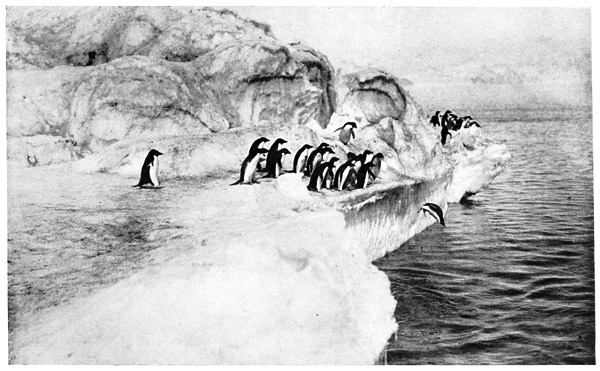
Fig. 46. DIVING FLAT INTO SHALLOW WATER
(Page 83)
A dead silence would ensue till a few seconds
later, when they would all come to the surface
some twenty or thirty yards out, and start rolling
about and splashing in the water, cleaning themselves
and making sounds exactly like a lot of boys
calling out and chaffing one another.
So extraordinary was this whole scene, that on
first witnessing it we were overcome with astonishment,
and it seemed to us almost impossible that
the little creatures, whose antics we were watching,
were actually birds and not human beings. Seemingly
reluctant as they had been to enter the water,
when once there they evinced every sign of enjoyment,
and would stay in for hours at a time.
As may be imagined, the penguins spent a great
deal of time on their way to and from the water,
especially during the earlier period before the sea-ice
had broken away from the ice-foot, as they had
so far to walk before arriving at the open leads.
As a band of spotless bathers returning to the
rookery, their white breasts and black backs
glistening with a fine metallic lustre in the sunlight,
met a dirty and bedraggled party on its way
out from the nesting ground, frequently both
would stop, and the clean and dirty mingle
together and chatter with one another for some
minutes. If they were not speaking words in
some language of their own, their whole appearance
belied them, and as they stood, some in pairs,
some in groups of three or more, chattering amicably
together, it became evident that they were
sociable animals, glad to meet one another, and,
like many men, pleased with the excuse to forget
for a while their duties at home, where their mates
were waiting to be relieved for their own spell off
the nests.
After a variable period of this intercourse, the
two parties would separate and continue on their
respective ways, a clean stream issuing from the
crowd in the direction of the rookery, a dirty one
heading off towards the open water, but here it
was seen that a few who had bathed and fed,
and were already perhaps half-way home, had been
persuaded to turn and accompany the others, and
so back they would go again over the way they
had come, to spend a few more hours in skylarking
and splashing about in the sea.
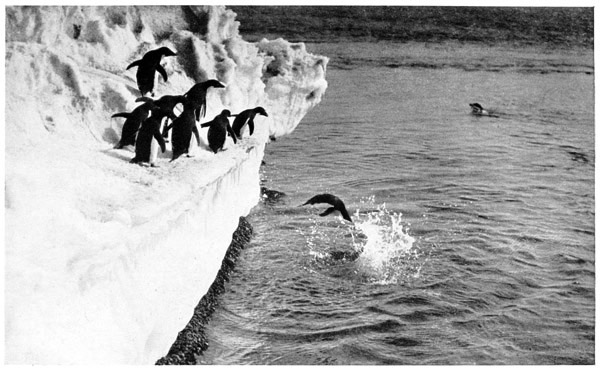
Fig. 47. DIVING FLAT INTO SHALLOW WATER
(Page 83)
In speaking of these games of the penguins, I
wish to lay emphasis on the fact that these hours
of relaxation play a large part in their lives during
the advanced part of the breeding period. They
would spend hours in playing at a sort of “touch
last” on the sea-ice near the water's edge. They
never played on the ground of the rookery itself,
but only on the sea-ice and the ice-foot and in the
water, and I may here mention another favourite
pastime of theirs. I have said that the tide
flowed past the rookery at the rate of some five or
six knots. Small ice-floes are continually drifting
past in the water, and as one of these arrived at
the top of the ice-foot, it would be boarded by a
crowd of penguins, sometimes until it could hold
no more. (Fig. 39.) This “excursion boat,” as
we used to call it, would float its many occupants
down the whole length of the ice-foot, and if
it passed close to the edge, those that rode on
the floes would shout at the knots of penguins
gathered along the ice-foot (Fig. 40) who would
shout at them in reply, so that a gay bantering
seemed to accompany their passage past the
rookery.
Arrived at the farther end, some half a mile
lower down, those on the “excursion boat” had
perforce to leave it, all plunging into the tide and
swimming against this until they came to the top
again, then boarded a fresh floe for another ride
down. All day these floes, often crowded to their
utmost capacity, would float past the rookery.
Often a knot of hesitating penguins on the ice-foot,
on being hailed by a babel of voices from a
floe, would suddenly make the plunge, and all
swim off to join their friends for the rest of the
journey, and I have seen a floe so crowded that as
a fresh party boarded it on one side, many were
pushed off the other side into the water by the
crush.
Once, as we stood watching the penguins bathing,
one of them popped out of the water on to the
ice with a large pebble in its mouth, which it had
evidently fetched from the bottom. This surprised
me, as the depth of the sea here was some ten
fathoms at least. The bird simply dropped the
stone on the ice and then dived in again, so that
evidently he had gone to all the trouble of diving
for the stone simply for the pleasure of doing it.
Mr. J. H. Gurney, in his book on the gannet, says
they (gannets) are said to have got themselves
entangled in fishing-nets at a depth of 180 ft. and
that their descent to a depth of 90 ft. is quite
authentic, so that perhaps the depth of this penguin's
dive was not an unusual one.
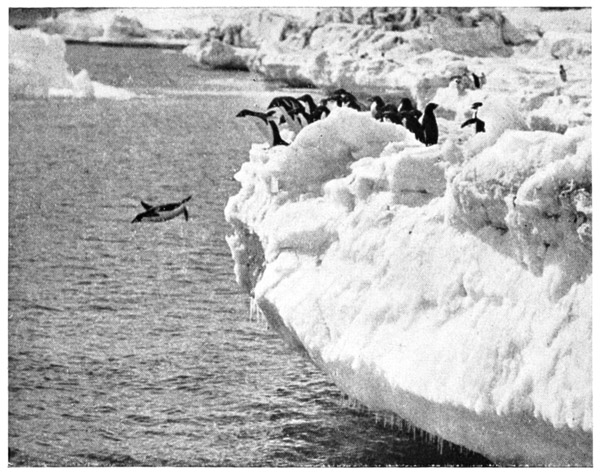
Fig. 48. Diving Flat
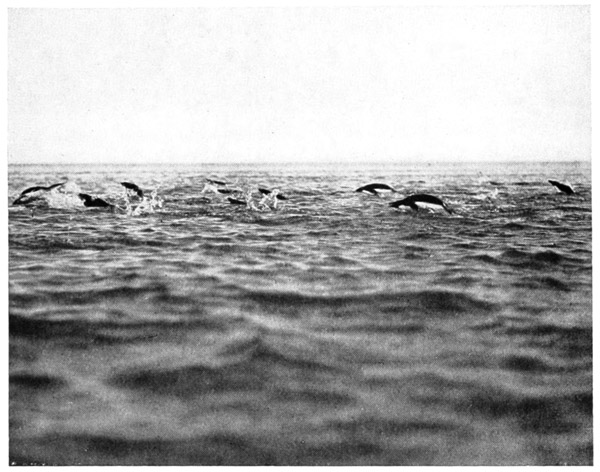
Fig. 49. Adélies “Porpoising”
(Page 80)
The tide at the open water leads where they
bathed ran a good six knots, but the Adélies swam
quite easily against this without leaving the surface.
In the water, as on the land, they have two means
of progression. The first is by swimming as a duck
swims, excepting that they lie much lower in the
water than a duck does, the top of the back being
submerged, so that the neck sticks up out of the
water. As their feet are very slightly webbed, they
have not the advantages that a duck or gull has
when swimming in this way, but supplement their
foot-work by short quick strokes of their flippers.
This they are easily able to do, owing to the depth
to which the breast sinks in the water.
The second method is by “porpoising.”
This consists in swimming under water, using
the wings or “flippers” for propulsion, the action of
these limbs being practically the same as they would
be in flying. As their wings are beautifully shaped
for swimming, and their pectoral muscles extraordinarily
powerful, they attain great speed, besides
which they are as nimble as fish, being able completely
to double in their tracks in the flash of a
moment. In porpoising, after travelling thirty feet
or so under water, they rise from it, shooting clean
out with an impetus that carries them a couple of
yards in the air, then with an arch of the back they
are head first into the water again, swimming a few
more strokes, then out again, and so on.
I show a photograph of them doing this (Fig. 49).
Perhaps the most surprising feat of which the
Adélie is capable is seen when it leaps from the
water on to the ice. We saw this best later in the
year when the sea-ice had broken away from the ice-foot,
so that open water washed against the ice cliff
bounding the land. This little cliff rose sheer from
the water at first, but later, by the action of the
waves, was under-cut for some six feet or more in
places, so that the ledge of ice at the top hung forwards
over the water. The height of most of this
upper ledge varied from three to six feet.
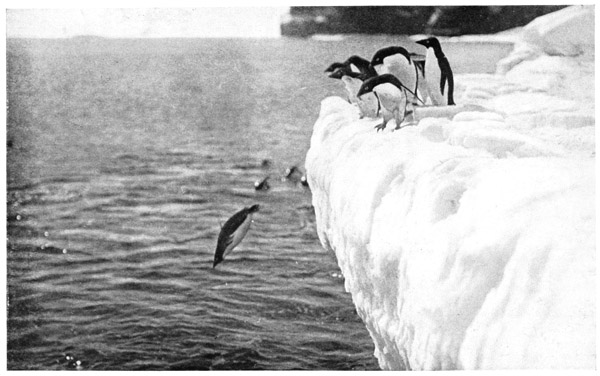
Fig. 50. A PERFECT DIVE INTO DEEP WATER
(Page 83)
Whilst in the water the penguins usually hunted
and played in parties, just as they had entered it,
though a fair number of solitary individuals were
also to be seen. When a party had satisfied their
appetites and their desire for play, they would swim
to a distance of some thirty to forty yards from the
ice-foot, when they might be seen all to stretch
their necks up and take a good look at the proposed
landing-place. Having done this, every bird would
suddenly disappear beneath the surface, not a
ripple showing which direction they had taken, till
suddenly, sometimes in a bunch, sometimes in a
stream, one after the other they would all shoot
out of the water, clean up on to the top of the ice-foot.
(Figs. 41 and 42.) Several times I measured
the distance from the surface of the water to the
ledge on which they landed, and the highest leap
I recorded was exactly five feet. The “take off”
was about four feet out from the edge, the whole
of the necessary impetus being gained as the bird
approached beneath the water.
The most important thing to note about this
jumping from the water was the accuracy with
which they invariably rose at precisely the right
moment, the exact distance being judged during
their momentary survey of a spot from a distance,
before they dived beneath the water, and carried in
their minds as they approached the ice. I am sure
that this impression was all they had to guide them,
as with a ripple on the water, and at the pace they
were going, they could not possibly have seen their
landing-place at all clearly as they approached it,
besides which, in many cases, the ledge of ice on
which they landed projected many feet forwards
from the surface, yet I never saw them misjudge
their distance so as to come up under the overhanging
ledge.
During their approach they swam at an even
distance of about three or four feet beneath the
surface, projecting themselves upwards by a sudden
upward bend of the body, at the same time using
their tail as a helm, in the manner well shown in
one of my photographs, in which one of the
birds is seen in the air at the moment it left the
water, the tail being bent sharply up towards the
back.
Their quickness of perception is shown very well
as they land on the ice. If the surface is composed
of snow, and so affords them a good foothold, they
throw their legs well forward and land on their
feet, as shown in Figs. 41 and 42, but should they
find themselves landing on a slippery ice-surface,
they throw themselves forward, landing on their
breasts in the tobogganing position as shown in
Fig. 43.
The Adélies dive very beautifully. We did not
see this at first, before the sea-ice had gone out,
because to enter the water they had only to drop
a few inches, but later, when entering from the ice
terraces, we constantly saw them making the most
graceful dives.

Fig. 51. SEA-LEOPARDS “LURK BENEATH THE OVERHANGING LEDGES OF THE ICE-FOOT, OUT OF SIGHT OF THE BIRDS OVERHEAD”
(Page 84)
At the place where they most often went in, a
long terrace of ice about six feet in height ran for
some hundreds of yards along the edge of the water,
and here, just as on the sea-ice, crowds would stand
near the brink. When they had succeeded in
pushing one of their number over, all would crane
their necks over the edge (Fig. 44), and when
they saw the pioneer safe in the water, the rest
followed.
When diving into shallow water they fall flat
(Figs. 45, 46, and 47), but into deep water, and from
any considerable height, they assume the most perfect
positions (Fig. 50) and make very little splash.
Occasionally we saw them stand hesitating to dive
at a height of some twenty feet, but generally they
descended to some lower spot, and did not often
dive from such a height, but twelve feet was no
uncommon dive for them.
The reluctance shown by each individual of a
party of intending bathers to be the first to enter
the water may partly have been explained when,
later on, we discovered that a large number of
sea-leopards were gathered in the sea in the neighbourhood
of the rookery to prey on the penguins.
These formidable animals, of which I show some
photographs, used to lurk beneath the overhanging
ledges of the ice-foot, out of sight of the birds
on the ice overhead. (Fig. 51.) They lay quite
still in the water, only their heads protruding, until
a party of Adélies would descend into the water
almost on top of them, when with a sudden dash
and snap of their great formidable jaws, they would
secure one of the birds.
It seemed to me then, that all the chivvying
and preliminaries which they went through before
entering the water, arose mainly from a desire on
the part of each penguin to get one of its neighbours
to go in first in order to prove whether the coast
was clear or not, though all this manœuvring was
certainly taken very lightly, and quite in the nature
of a game. This indeed was not surprising, for of
all the animals of which I have had any experience,
I think the Adélie penguin is the very bravest.
The more we saw of them the fonder we became
of them and the more we admired their indomitable
courage. The appearance of a sea-leopard in their
midst was the one thing that caused them any panic.
With dozens of these enemies about they would
gambol in the sea in the most light-hearted manner,
but the appearance of one among them was the
signal for a stampede, but even this was invariably
gone through in an orderly manner with some show
of reason, for, porpoising off in a clump, they at
once spread themselves out, scattering in a fan-shaped
formation as they sped away, instead of
all following the same direction.
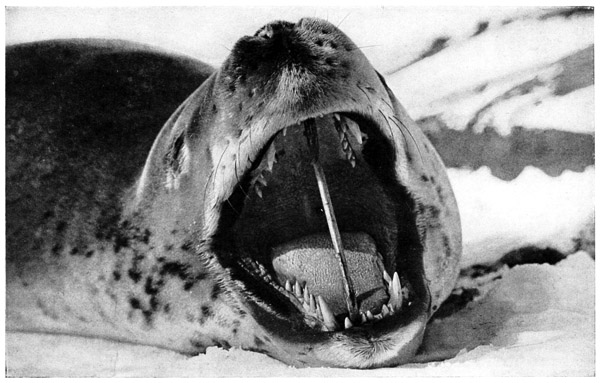
Fig. 52. A SEA-LEOPARD'S HEAD
(Page 87)
As far as I could judge, however, the sea-leopards
are a trifle faster in the water than the Adélies, as
one of them occasionally would catch up with one
of the fugitives, who then, realizing that speed alone
would not avail him, started dodging from side to
side, and sometimes swam rapidly round and round
in a circle of about twelve feet diameter for a full
minute or more, doubtless knowing that he was
quicker in turning than his great heavy pursuer, but
exhaustion would overtake him in the end, and we
could see the head and jaws of the great sea-leopard
rise to the surface as he grabbed his victim. The
sight of a panic-stricken little Adélie tearing round
and round in this manner was a sadly common
sight late in the season.
Sea-leopards are no mean customers and should
be treated with caution. Commander Campbell
and I used to hunt them from a little Norwegian
pram (a species of dinghy) which we rowed quietly
up and down close under the ice-foot, shooting at
the sea-leopards with a rifle when we saw their
heads above water.
One day we had an interesting little adventure.
We had shot and killed one, a fine bull about ten feet
long, which had sunk to the bottom in some five
fathoms. Having just pulled away from him, we
were about ten yards from the ice-foot, when another
very large sea-leopard overtook us, swimming from
the direction of the dead bull. It passed under the
pram, bumping against the keel in doing so.
When about ten yards ahead of us it turned
and made straight back for us, but as we were
bows-on to it, it came right alongside the boat,
churning up the water and wetting us. At this
moment it turned on its side, its right fore-flipper
beating the surface and its belly towards us, and
was just starting to rear its head up when we both
lunged at it with our paddles, and so pushed the
little boat away from it. This brought us alongside
the ice-foot, from which Campbell got a shot at it
half a minute later, and wounded it in the neck.
The moment after we lunged at it with our paddles
it dived, then reappeared ten or fifteen yards off,
rearing its head out of the water, and it was at this
moment that Campbell shot it. After this it
reappeared several times at the surface, but drifted
away with the tide and we lost it.

Fig. 53. A Sea-Leopard 10 ft. 6½ ins. long
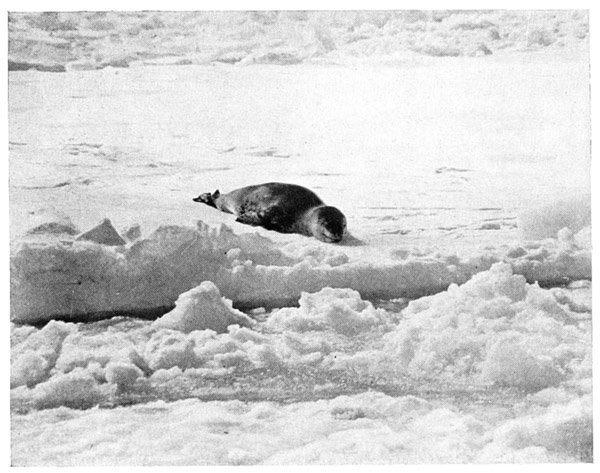
Fig. 54. A Young Sea-Leopard on Sea-Ice
(Page 87)
The sea-leopard has not a reputation for attacking
men in boats, and this one may have been actuated
by curiosity merely, but in favour of its meaning to
attack us were, first, that it came to us straight
from the direction of the dead bull we had shot,
and secondly, that it seems hardly likely that after
bumping against our keel, mere curiosity could
have tempted it to come back and try to look over
the gunwale! As a rule we had to drift very
quietly along when hunting sea-leopards, as the
slightest sound frightened them away.
All that we could do to protect our friends was
to shoot as many of these sea-leopards as possible
but though we may have made some difference,
there were always many about.
Some idea of the depredations committed by
these animals may be gathered from the fact that
in the stomach of one which we shot I found the
bodies of eighteen penguins, in various stages of
digestion, the beast's intestines being literally
stuffed with the feathers remaining from the disintegration
of many more. Photographs of these
animals are seen in Figs. 52, 53, and 54.
Though the actual presence of a sea-leopard
put the Adélies to confusion, causing them to
“porpoise” madly away for a few hundred yards,
yet once away from the immediate neighbourhood
of the arch enemy, they appeared to think no more
of him, and behaved as though there were no
further need for anxiety, though probably they
kept a sharp look-out nevertheless. Evidence
goes to show that the sea-leopard is the only living
enemy, excepting man, that threatens the life of
the adult Adélie penguin.
One day, as I watched some hundreds of Adélies
bathing in an open lead, suddenly the back of an
enormous killer-whale (Orca gladiator) rose above
the surface as it crossed the lead from side to side,
appearing from beneath the ice on one side and
disappearing beneath it on the other. To my
surprise, not the slightest fear was shown by the
birds in the water. Had this beast been a sea-leopard,
there would have been a stampede, and
every bird have leapt from the water on to the sea-ice.
On this evidence I formed the opinion that in
all probability killer-whales do no harm to Adélie
penguins; later I saw it confirmed, when a school
of killers shaved close past several floes that were
crowded with Adélies, and made not the least
attempt to get at them, as they might so easily
have done by upsetting the floes. Very probably
this is because the agile bird can escape with such
ease from the ponderous whale, and fears it no more
than a terrier fears a cow, though he thinks twice
before coming within reach of its jaws.
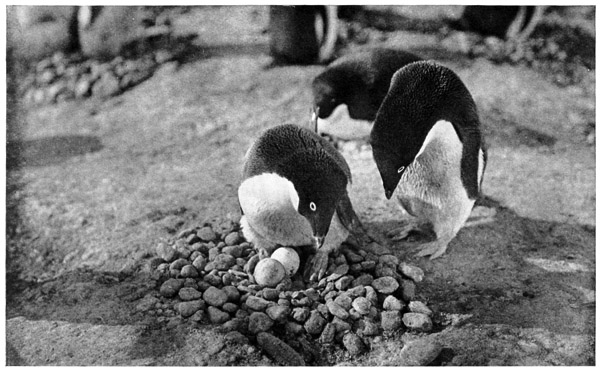
Fig. 55. “WITH GRACEFUL ARCHING OF HIS NECK, APPEARED TO ASSURE HER OF HIS READINESS TO TAKE CHARGE”
(Page 90)
When the sea-ice had gone out, leaving open
water right up to the ice-foot, a ledge of ice was
left along the western side of the rookery, forming
a sort of terrace or “front,” with its sides composed
of blue ice, rising sheer out of the water to a height
of some six feet or more in places. From this point
of vantage it was possible to stand and watch the
penguins as they swam in the clear water below,
and some idea was formed of their wonderful
agility when swimming beneath the surface. As
they propelled themselves along with powerful
strokes of their wings, they swerved from side to
side to secure the little prawn-like euphausia which
literally swarm everywhere in the Antarctic seas,
affording them ample food at all times. Their
gluttonous habits here became very evident. They
would gobble euphausia until they could hold no
more, only to vomit the whole meal into the water
as they swam, and so enlightened start to feast
again. As they winged their way along, several
feet beneath the surface, a milky cloud would
suddenly issue from their mouths and drift slowly
away down stream, as, without the slightest pause
in their career, they dashed eagerly along in the
hunt for more.
When a penguin returned to his mate on the
nest, after his jaunt in the sea, much formality had
to be gone through before he was allowed to take
charge of the eggs. This ceremony of “relieving
guard” almost invariably was observed.
Going up to his mate, with much graceful arching
of his neck, he appeared to assure her in guttural
tones of his readiness to take charge (Fig. 55).
At this she would become very agitated, replying
with raucous staccato notes, and refusing to budge
from her position on the eggs. Then both would
become angry for a while, arguing in a very heated
manner, until at last she would rise, and, standing
by the side of the nest, allow him to walk on to
it, which he immediately did, and after carefully
placing the eggs in position, sink down upon them,
afterwards thrusting his bill beneath his breast to
push them gently into a comfortable position.
After staying by him for a little while, the other
at length would go off to bathe and feed.
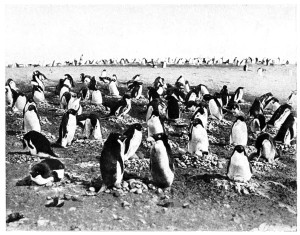
Fig. 56. “The Chicks began to appear”
(A Typical Group of Nests)
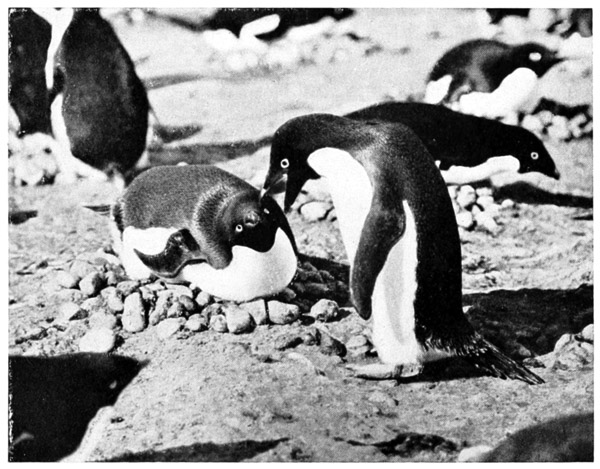
Fig. 57. An Adélie being Sick
(Page 94)
The length of time during which each bird was
away varied considerably, but a “watch bill” was
kept of one particular pair with the following
result:(5)
Nov. 14. Egg laid. Hen sitting.
Nov. 27. A cock seen to join the hen for the
first time since the 14th. He took
her place on the nest. This was the
first day on which any red guano
was seen about the nest.
Dec. 10. The hen returned between 8 P.M. and
10 P.M., having been absent since
November 27. Fresh red guano:
the first for many days.
Dec. 14. The cock relieved the hen between
8 A.M. and 10 A.M.
Dec. 15. The hen relieved the cock between
8 A.M. and 10 A.M. Between 6 P.M.
and 8 P.M. the chick was hatched, the
hen remaining on the nest.
Dec. 17. At 8 A.M. the cock was found to have
relieved the hen.
Dec. 18. Hen mounted guard between 6 P.M.
and 8 P.M.
Dec. 20. Cock relieved guard about 8 A.M. At
8 P.M. both cock and hen were at
the nest, the hen standing by it, the
cock on it.
Dec. 21. The hen relieved guard at 8 P.M.
Dec. 23. Cock came back at noon and relieved
guard.
Dec. 24. The cock remained on guard all day.
The hen was gone from 1 P.M. till 6
P.M., when she returned and relieved
guard.
Dec. 25. 8 A.M. Both at nest, hen still on.
10 A.M. changed guard. Hen gone.
Dec. 26. Hen on nest. Cock standing near.
Dec. 27. 8 A.M. Cock on nest.
Dec. 28. 8 A.M. Hen on nest.
Dec. 29. Cock relieved guard.
Dec. 30. Hen arrived 3 P.M. and relieved guard.
Dec. 31. 10 P.M. to midnight, changed, cock on.
Both there at 10 P.M.
Jan. 1. 10 A.M. Both at nest.
12 noon. Both at nest. The youngster
complicating matters by running
away every time he was passed by
the observer, thus getting himself
and his parents embroiled with the
neighbours.
Jan. 1. 2 P.M. Hen on nest. Cock gone.
Jan. 2. 10 A.M. Hen on nest.
12 noon. Chick disappeared.
2 P.M. Nest deserted.
4 P.M. Cock on nest. No chick.
8 P.M. Cock on nest. No chick.
Jan. 3. Cock on the nest with the chick.
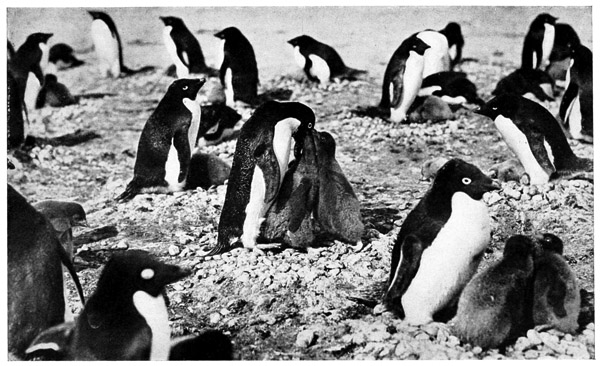
Fig. 58. METHOD OF FEEDING THE YOUNG
(Page 94)
From the above Table it will be seen that the
hen was not relieved by the cock until a fortnight
after she had laid her egg (in this case there was
only one) so that probably she had been without
food for a month. Then she left, and only returned
to relieve the cock after the lapse of another fortnight,
it being worth remarking that each was
absent for the same length of time. When the
chick was hatched, a different régime began, as of
course the chick had to be fed and journeys to the
sea made at regular intervals for the purpose of
getting food.
When the chicks began to appear all over the
rookery (Fig. 56), a marked change was noticed in
the appearance of the parents as they made their
way on foot from the water's edge to the nests.
Hitherto they had been merely remarkable for
their spotless and glistening plumage, but now they
were bringing with them food for the young, and
so distended were their stomachs with this, that
they had to lean backward as they walked, to
counterbalance their bulging bellies, and in consequence
frequently tripped over the inequalities of
the ground which were thus hidden from their gaze.
What with the exertion of tramping with their
burden across the rookery, and perhaps on rare
occasions one or two little disputes with other
penguins by the way, frequently they were in some
distress before they reached their destination, and
quite commonly they would be sick and bring up
the whole offering before they got there. Consequently,
little red heaps of mashed up and half
digested euphausia were to be seen about the
rookery. Once I saw a penguin, after he had
actually reached the nest, quite unable to wait for
the chick to help itself in the usual manner, deposit
the lot upon the ground in front of his mate. I saw
what was coming and secured the accompanying
photograph of the incident. (Fig. 57.) When
this happens the food is wasted, as neither chick
nor adult will touch it however hungry they may
be, the former only feeding by the natural method
of pushing his head down the throat of a parent, and
so helping himself direct from the gullet. (Fig. 58.)

Fig. 59. PROFILE OF AN ADÉLIE CHICK
(Page 95)
When the chicks are small they are kept completely
covered by the parent who sits on the nest.
They grow, however, at an enormous rate, gobbling
vast quantities of food as it is brought to them,
their elastic bellies seeming to have no limit to their
capacity (Fig. 59); indeed, when standing, they
rest on a sort of tripod, formed by the protuberant
belly in front and the two feet behind.
I weighed a chick at intervals for some time, and
this was the astonishing result:
| Ounces | |
|---|---|
| The egg | 4·56 |
| The chick when hatched | 3·00 |
| Five days old | 13·00 |
| Six days old | 15·75 |
| Eight days old | 24·75 |
| Nine days old | 28·50 |
| Eleven days old | 37·75 |
| Twelve days old | 42·50 |
To see an Adélie chick of a fortnight's growth
trying to get itself covered by its mother is a most
ludicrous sight. The most it can hope for is to get
its head under cover, the rest of its body being
exposed to the air; but the downy coat of the chick
is close and warm, and suffices in all weathers to
protect it from the cold. Fig. 60 illustrates what
I have said very well, whilst Fig. 61 shows a mother
with a chick twelve days old.
Whilst the chicks are small the two parents
manage to keep them fed without much difficulty;(6)
but as one of them has always to remain at the
nest to keep the chicks warm, guard them from
skuas and hooligan cocks, and prevent them from
straying, only one is free to go for food. Later on,
however, two other factors introduce themselves.
The first of these is that the chick's downy coats
become thick enough to protect them from cold
without the warmth of the parent; and the second
that as the chicks grow they require an ever-increasing
quantity of food, and at the age of about
a fortnight this demand becomes too great for one
bird to cope with. At this time it is still necessary
to prevent the chicks from straying and to protect
them from the skuas and “hooligans,” and so to
meet these two demands a most interesting social
system is developed. The individual care of the
chicks by their parents is abandoned, and in place
of this, colonies start to “pool” their offspring,
which are herded together into clumps or “crèches,”
each of which is guarded by a few old birds, the
rest being free to go and forage.
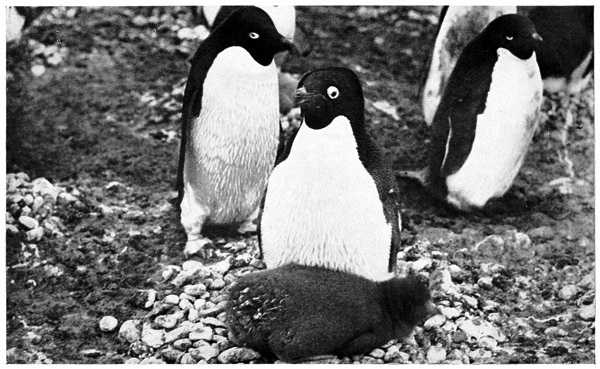
Fig. 60. A TASK BECOMING IMPOSSIBLE
(Page 95)
It is quite likely that if a chick which has escaped
from its own crèche joins another crèche it will get
fed there, as it seems hardly possible for the adults
to recognize the individuals of so large a gathering
and to detect a stranger should one turn up, but
there is good reason to believe that the old birds
work for their own crèches only, and remain faithful
to them for the rest of the season, because, as
they make their way across the rookery, laden with
the food they are bringing from the sea, it is sadly
common to see them pursued by strayed and
starving youngsters, plaintively piping their prayers
for a meal; and these appeals are always made in
vain, the old birds turning a deaf ear to the
youngsters, who at last, weary and weak, give up
the pursuit, and in the end fall a prey to the ever-watchful
skuas. Further evidence is found in the fact
that the chicks at the very back of the rookery and
up at the top of the Cape are just as well nourished
as those nearer the water, who are constantly passed
by a stream of food-laden parents.
Twice already I have mentioned that strayed
chicks fall a prey to “hooligan” cocks. These
hang about the rookery often in little bands. At
the beginning of the season there are very few of
them, but later they increase greatly, do much
damage, and cause a great deal of annoyance to the
peaceful inhabitants. The few to be found at first
probably are cocks who have not succeeded in
finding mates, and consequently are “at a loose
end.” Later on, as their numbers are so greatly
increased, they must be widowers, whose mates
have lost their lives in one way or another.
Many of the colonies, especially those nearer the
water, are plagued by little knots of “hooligans,”
who hang about their outskirts, and should a chick
go astray it stands a good chance of losing its life at
their hands. The crimes which they commit are
such as to find no place in this book, but it is
interesting indeed to note that, when nature intends
them to find employment, these birds, like men
degenerate in idleness.
Some way back I made some allusion to the way
in which many of the penguins were choosing sites
up the precipitous sides of the Cape at the back of
the rookery. Later I came to the conclusion that
this was purely the result of their love of climbing.
There was one colony at the very summit of the
Cape,(7) whose inhabitants could only reach their
nests by a long and trying climb to the top and
then a walk of some hundred yards across a steep
snow slope hanging over the very brink of a sheer
drop of seven hundred feet on to the sea-ice.
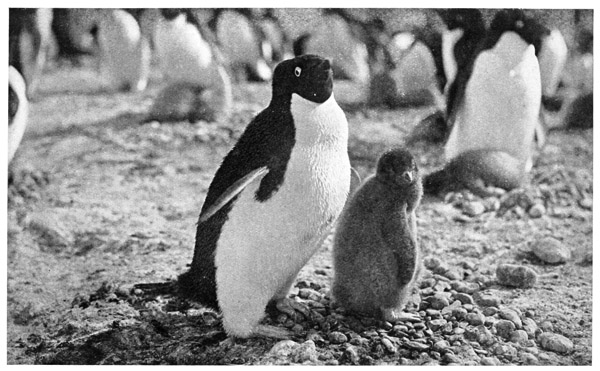
Fig. 61. ADÉLIE WITH CHICK TWELVE DAYS OLD
(Page 96)
During the whole of the time when they were
rearing their young, these mountaineers had to make
several journeys during each twenty-four hours to
carry their enormous bellyfuls of euphausia all the
way from the sea to their young on the nests—a
weary climb for their little legs and bulky bodies.
The greater number who had undertaken this did
so at a time when there were ample spaces unoccupied
in the most eligible parts of the rookery.
I have mentioned that large masses of ice were
stranded by the sea along the shores of the rookery.
These fragments of bergs, some of them fifteen
to twenty feet in height, formed a miniature
mountain range along the shore. All day parties of
penguins were to be seen assiduously climbing the
steep sides of this little range. Time after time,
when half way up, they would descend to try
another route, and often when with much pains
one had scaled a slippery incline, he would come
sliding to the bottom, only to pick himself up and
have another try. (Fig. 63.)
Generally, this climbing was done by small
parties who had clubbed together, as they generally
do, from social inclination. It was not unusual for
a little band of climbers to take as much as an
hour or more over climbing to the summit.
Arrived at the top they would spend a variable
period there, sometimes descending at once, sometimes
spending a considerable time there, gazing
contentedly about them, or peering over the edge
to chatter with other parties below.
Again, about half a mile from the beach, a large
berg some one hundred feet in height was grounded
in fairly deep water, accessible at first over the sea-ice,
but later, when this had gone, surrounded by
open water. Its sides were sheer except on one side,
which sloped steeply from the water's edge to the top.
From the time when they first went to the sea to
feed until the end of the season, there was a continual
stream of penguins ascending and descending
the berg. As I watched them through glasses I
saw that they had worn deep paths in the snow from
base to summit. They had absolutely nothing to
gain by going to all this trouble but the pleasure
they seemed to derive from the climb, and when
at the top, merely had a good look round and came
down again.
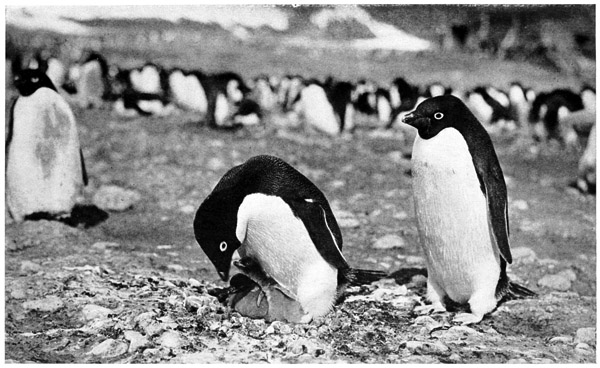
Fig. 62. A COUPLE WITH THEIR CHICKS
(Page 96)
When the birds were arriving at the rookery I
watched for those who were to nest up the cliff, and
several times saw birds on arriving at the rookery
make for the heights without any hesitation, threading
their way almost in a straight line through the
nests to the screes at the bottom of the cliff, and
up these to one or other of the paths leading up its
side. Probably these had been hatched there, or
had nested there before, and were making their
way to their old haunts, but my notes on their
nesting habits go to show that the cocks, at any
rate, cannot keep to the same spot during successive
years. It is the hen who chooses the site, and
stays on it, as I have shown, until a mate comes to
her, and wins her, very often only after defeating
many other competitors.
The waste of life in an Adélie rookery is very
great, and is due to the following causes:
- The eggs.
- Skuas.
- Cocks fighting among the nests.
- Floods from thaw water.
- Death of parents.
- Snow-drifts.
- Landslides.
- The young chicks.
- Skuas.
- Landslides.
- “Hooligan” cocks.
- Getting lost.
- Death of parents.
- Adults.
- Sea-leopards.
- Landslides.
- Snow-drifts.
In the above lists I have made no mention of
the wanton depredations committed—owing to the
licence given to ignorant seamen—by expeditions
which visit the Antarctic from time to time, but as
these visits are made at rare intervals, they cannot
greatly affect the population.
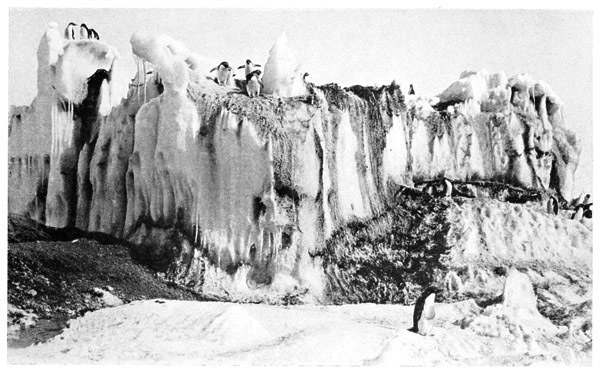
Fig. 63. ADÉLIE PENGUINS HAVE A STRONG LOVE OF CLIMBING FOR ITS OWN SAKE
(Page 99)
Some of the items in my list require explanation.
The screes at the foot of the cliff at Cape Adare
are perhaps the most thickly populated part of
the rookery. As the thaw proceeds, boulders of
different sizes are continually falling down the
cliff, some of them for many hundreds of feet
before they finally plunge in among the nests on
the screes, doing terrible damage, and often rolling
some distance out into the rookery. At other
times, owing to the bursting out of thaw water
which has been dammed up at the top of the cliff,
large landslides are caused which bury many
hundreds of nests beneath them. In fact, these
screes on which the nests are built have been
formed by these landslides taking place from year
to year, and no doubt form the graves of thousands
upon thousands of former generations. One of
these slides took place whilst we were at the
rookery, doing terrible damage. A crowded
colony of Adélies were nesting just below, and the
avalanche passed right through and over them,
causing the most sad havoc. We found hundreds
of injured and dying, some of them in a pitiable
condition. Several were completely disembowelled,
others had the whole skin of their backs torn down
and hanging behind them in a flap, exposing the
bare flesh. Dozens had broken or dislocated legs
and flippers.
The worst feature was that many were buried
alive beneath the snow, or pinned down to the ground
by masses of basalt. Twice I saw one flipper sticking
out of the snow, moving dismally, and dug out in
each case a badly injured bird which would have
lingered perhaps for days, because loose snow does
not always suffocate, owing to the amount of air
contained in its interstices, and to the fact that
diffusion takes place through it very readily. Several
of us spent a long time in killing with ice-axes those
that seemed too badly injured to recover.
It was remarkable to see the way in which all the
nests which had escaped the avalanche, however
narrowly, were still sat upon by their occupants, as
if nothing had happened. Also I saw several badly
injured birds sitting on their eggs, some of them
soaked in blood, so that they looked like crimson
parrots. The amount of bloodshed must have been
great, as the snow was dyed with blood in all directions.
As a cascade of water followed the avalanche,
and continued for some hours, spreading out into
little rivers among the nests, many were being
deluged, and some of the penguins actually were
sitting in the running water, in a vain attempt to
keep warm their drowned chicks and spoiled eggs.
Sometimes, digging at hazard in the drifted snow,
I came on birds that had been deeply buried, and
though they were held down and kept motionless by
the weight of the snow covering them, most of
them were alive, and I have no doubt many dozens
died a lingering death in this way. Such as had
merely suffered broken flippers or legs, I spared,
and the next day nearly all of these seemed to be
doing well. One bird I found sitting on two eggs
which were in the middle of a rivulet of water, so I
lifted them out and put them on dry ground close
by, but the parent would have nothing to do with
them after this.

Fig. 64. ADÉLIES ON THE ICE-FOOT
A feature of the above scene, which one could not
help noticing, was that however badly a penguin
was injured it was never molested by the others, as
is almost invariably the rule among other birds,
including their near neighbours the skuas. I have
seen a sick skua hunted continuously for over an
hour by a mob of its own kind who would not
allow it to settle on the ice for a moment's rest.
Another item of my list requiring explanation is
“snow-drifts.”
During both spring and summer there are occasional
snowstorms, and during these the birds sit
tight on their nests, sometimes being covered up by
drift. As a rule the bird on the nest keeps a space
open by poking its head upwards through the snow,
but sometimes it becomes completely buried. Air
diffuses so rapidly through snow that death does
not take place by suffocation, and the bird can live
for weeks beneath a drift, sitting on its nest in the
little chamber which it has thawed out by its own
warmth. Generally after a few hours the snow
abates and settles down sufficiently to expose the
nest once more, but sometimes a breeze springs up
which is not strong enough to blow the snow away,
but simply hardens the surface of the drift into a
crust which lasts for several weeks, and the birds
are imprisoned in consequence. Then little black
dots are seen about the surface of the drift, which
are the heads of penguins thrust through their
breathing holes.
On one such occasion I witnessed an interesting
little incident. An imprisoned hen was poking
her neck up through her breathing hole when her
mate spied her and came up. He appeared to be
very angry with her for remaining so long on the
nest, being unable to grasp the reason, and after
swearing at her for some time he started to peck
at her head, she retaliating as far as her cramped
position would allow. When she withdrew her
head, he thrust his down the hole till she drove it
out again, and as this state of things seemed to be
going on indefinitely, I came up and loosened the
crust of snow which imprisoned her, on which she
burst out, and seemed glad to do so. She was
covered with mire, having for many days been
sitting in a pool of thaw water which had swamped
her nest and evidently spoilt the eggs. When
I put her back on the nest, she sat there for
some time, but eventually they both deserted. I
should say that some hundreds of nests were spoilt
in this way.
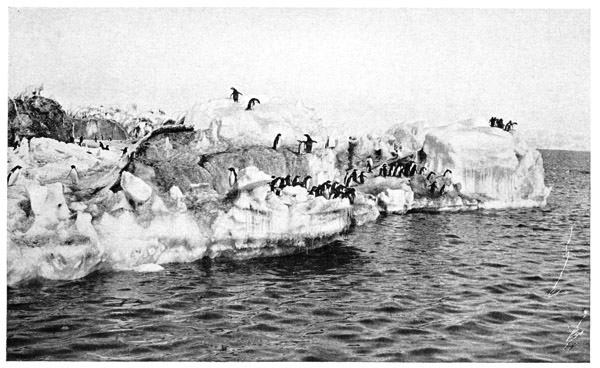
Fig. 65. ADÉLIES ON THE ICE-FOOT
As I photographed the above incident at intervals,
different stages are seen on Figs. 67 to 69.
I have mentioned that eggs got lost owing to
cocks fighting among the nests. When hens are
incubating the eggs they never leave the nest
under any circumstances until relieved by their
mates, being most reliable and faithful to their
charge. They squabble continually with their
nearest neighbours, whom they seem to hate, but
only retaliate on those within reach, using their
bills only to peck at each other's heads without
shifting their position.
The cocks, however, are less dependable. Starting
a quarrel in the same way as the hens do, their
militant instincts soon became aroused, on which
they are apt to jump up and start a furious fight
with flippers, staggering to and fro over their
nests, and very often spilling the eggs, which are
lost in consequence. On certain occasions I was
able to interfere between the combatants, and replace
the eggs, on which they would return to
their domestic duties and seem to forget the
incident. A good many eggs must have been
lost in this way during the season.
Late in the season an occurrence took place for
which I have never been able to find any explanation.
Occasionally I had noticed that the
penguins had crowded together more than usual
on the ice-foot, multitudes of them standing for
hours without any apparent purpose. A good
idea of this scene may be got from the frontispiece.
One morning Mr. Priestley came into the hut
and told me that “the penguins were drilling on
the sea-ice,” and that I had better come and look
at them. I went with him to the ice-foot, and
this is what we saw.
Many thousands of Adélies were on the sea-ice
between the ice-foot and the open water leads,
then some quarter of a mile distant. Near the
ice-foot they were congregating in little bands of
a few dozen, whilst farther out near the water,
massed bands some thousands strong stood silent
and motionless. Both the small and the large
bands kept an almost rectangular formation, whilst
in each band all the birds faced the same way,
though different bands faced in different directions.
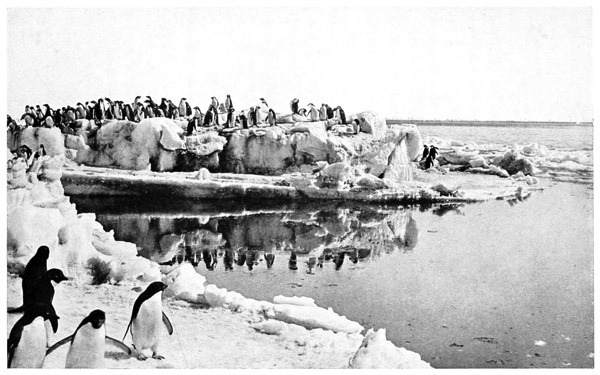
Fig. 66. ADÉLIES ON THE ICE-FOOT
As we watched it became evident that something
very unusual was going on. First, from one
of the small bands, a single bird suddenly appeared,
ran a few yards in the direction of another small
band, and stopped. In the flash of a moment the
entire band from which he came executed the
movement “left turn,” this bringing them all into
a position facing him. So well ordered was the
movement that we could scarcely believe our eyes.
Then from the small band our single bird had
approached, another single bird ran out, upon
which his own party did exactly as the first had
done, so that the two bands now stood facing
one another, some fifteen yards apart.

ARROW SHOWS DIRECTION IN WHICH ALL THE BIRDS FACED
Then
spontaneously, the two bands marched straight
toward one another, and joined to form one body.
After this we saw the same procedure being enacted
in many other places, the penguins coming down
from the rookery and forming small bands which
joined together. Then the augmented bodies
would join other augmented bodies, to form
still larger ones, which then joined together, and
so on until a great mass of birds stood together
in rows all facing in one direction like a regiment
of soldiers. One of these masses stood not far
from us, a compact rectangular gathering, as shown
on page 109.
They stood thus for a long time, quite motionless
and silent, when suddenly as before, a single
bird darted out from among the crowd and ran
a few yards toward the open water, when, as if
it had received a word of command, every bird
faced left as in the diagram below.
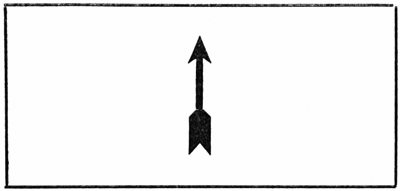
ARROW SHOWS DIRECTION IN WHICH ALL THE BIRDS FACED
After this the whole crowd marched for the
water, keeping its formation almost unchanged till
it arrived at the edge of the ice, when it halted, and
subsequently entered the water in batches.
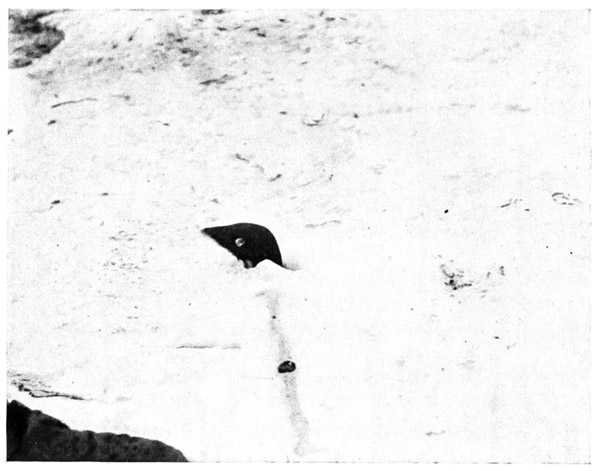
Fig. 67. “An Imprisoned Hen was Poking her Head up through her Breathing Hole”
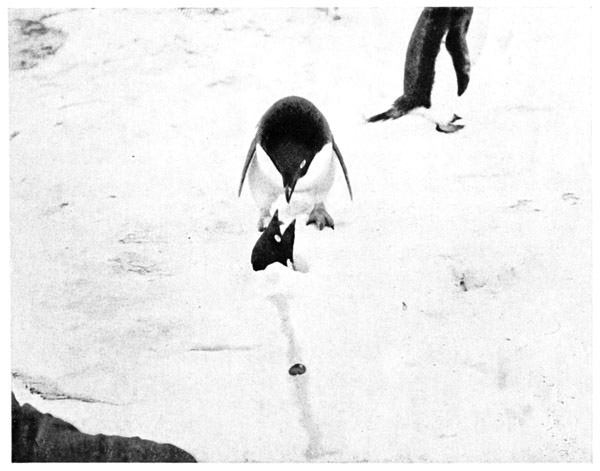
Fig. 68. “Her mate appeared to be very angry with her, being unable to grasp the reason why she could not come off the nest”
(Page 106)
This procedure continued for many hours, the
penguins that day observing this extraordinary
behaviour, the most astonishing part of which
lay in the accuracy of their drill-like movements, so
that we might have been watching a lot of soldiers
on parade. Perhaps the sudden motions of these
bodies of birds were brought about by a sound
uttered by the single bird which acted as leader,
though we did not hear this. The actual reason
for this departure from their usual customs is
beyond my knowledge. There was nothing to
be seen to account for it, but the penguins evidently
obeyed some instinct which affected them all on
this and two subsequent occasions, when the same
thing took place.
My own idea is that in former times the penguins
used to mass together as other birds do, before
their annual migration, perhaps as far back as
the day when their wings were adapted for flight,
and that the phenomenon described above was
a relic of their bygone instincts.
When the chicks' down has been moulted
and their plumage acquired, they proceed to the
water's edge and here they learn to swim.
In the autumn of 1912, at a small rookery which
I came upon on Inexpressible Island, I had an
opportunity of watching their first attempts in this
direction. Crowds of young Adélies were to be
seen on the pebbly beach below their rookery,
much of the ice having disappeared at this late
season, leaving bare patches of shingle which were
very suitable for the first swimming lesson.
Many old birds paddled in for a short distance,
and crouching in a few inches of water, splashed
about with their flippers to give the youngsters
a lead. Some of the latter needed little encouragement,
and took readily to the strange element, very
soon swimming about in deep water, but others
seemed more timid, and these latter were urged in
every possible way by the old birds, some of whom
could be seen walking in and out of the water, and
so doing what they could to give their charges
confidence.
In this duty one or two old birds might be seen
with a little crowd of youngsters, so that evidently
the social instincts which gave rise to the crèche
system in the first place were extended to the
tuition of the young and thus to their preparation
for the journey north.

Fig. 69. “When she broke out, they became reconciled”
(Page 106)
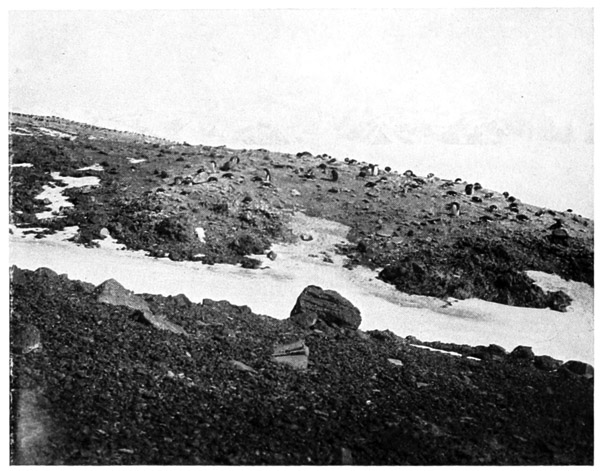
Fig. 70. Adélie's Nests on Top of Cape Adare, to reach which they must make a Precipitous Climb of 1000 feet
(Page 98)
Up in the rookery, fully fledged youngsters could
be seen clamouring in vain for food, the old birds
resolutely refusing to feed them now that they
were able to forage for themselves. The adults
who instructed the young in the water had finished
their moult, and were themselves ready to depart.
Many others, however, still wandered disconsolately
about the land, some of them only half fledged, and
moping under boulders or any sort of shelter from
the chilly breezes, and long after all the youngsters
had departed, solitary moulting birds were to
be found, emaciated and miserable, patches of
loose feathers still clinging to the new coat which
was making such a tardy growth. In some places
we found these old birds in holes under the rocks,
the old moulted feathers making some sort of a bed
which helped to protect their late wearers from the
cold.
Both at Cape Adare in 1910 and at Inexpressible
Island in 1911, I found that though young and old
left the rookery simultaneously at first, yet after all
the young had departed many adults still remained
behind owing to the lateness of their moult, and
this is directly at variance with the remarks of Mr.
Borchgravink on the subject, because he says that
the old birds all leave the rookery first, abandoning
the young, who are driven by necessity to take
to the water and learn to swim.
Well indeed was it for my companions and
me that this was so, for in the autumn of 1912
we were in sore straits for food, and had it not
been that at a very late date we collected some
ninety old moulting birds on Inexpressible Island,
I doubt if we would have seen the sun rise in the
next spring.
At Cape Adare in 1911, half the rookery had
departed when we arrived in the autumn. The
rest took to the sea in batches some hundreds
strong. These parties wandered about the beach
and ice-foot in company for some time, then entering
the water and swimming northward they were
seen no more.
Those that moulted sometimes remained solitary
whilst in the acuter stages, but nevertheless moulting
parties often were seen looking very miserable,
doubtless feeling in their unprotected state the
effects of winds which were getting keener and
more severe now that the sun was departing.
When all the youngsters had gone, some thousands
of old birds still remained, and waited for
many days after they had acquired their full
plumage before they left. Then these in time
disappeared, leaving the rookery empty and desolate.
On March 12 I photographed the last party: all
black-throated adults. Two days later a couple
appeared on the beach, apparently having come
back for a last look at us. Then these, too, disappeared,
and as we looked at the empty silent
beach we could not help contrasting it with the
noise and bustle of a short time ago.
The last penguin had gone, and the sun disappearing
below the horizon, left us alone with the
Antarctic night.
APPENDIX
APPENDIX
(A) Plumage and Soft Parts.
The following description of the plumage and
soft parts of Pygoscelis Adeliæ, which is perfectly
correct, is taken from the zoological report of the
Discovery Expedition.
Soft Parts.
“Bill, when first hatched, blackish. A week
old, black terminally, deep red at the gape and
along the cutting edges. Immature of the first
year, blackish. Adult, brick-red, the upper bill
black terminally, and the mandible black along the
cutting edge.
“Iris, brown; varying between reddish brown
and greenish brown.
“Eyelids, black throughout the first year; pure
white in the adult at fourteen months and onwards.
“Feet, flesh red; dusky when first hatched,
brightening in the first week or two. Immature
and adult, pale flesh pink above, black beneath (in
some cases piebald beneath).
“Claws, brown.”
In the majority of the chicks the down is
uniformly dark and sooty, but here and there, in
progeny of quite normal parents, one may find
nestlings of so pale a grey as to be almost silvery
white, with blackish heads, possibly a reversion to
an earlier type, and, at any rate, suggestive of the
young of the Emperor penguin, which perhaps
represents the oldest stock of all. According to
Dr. Bowdler Sharp, the colour of the head is in all
cases blacker in the earlier stages than the rest of
the body.(8)
As the chick ages the colour of its down
changes, and all of it takes on a dull rusty brown
colour. As it moults the abdomen and thighs
change first, and white feathers appear in place of
the down. Then come changes on the head, round
the bill, and at the tail; the upper breast, neck, and
back being the last parts to moult.
The feet, which in the young nestling have been
almost black, change in colour to a brick-red that
shows up very markedly against the rusty brown
down, looking as if the legs were raw and inflamed.
Later the permanent flesh colour is acquired, with
black plantar surfaces. The nails are black at first,
and later change to brown.
When the nestling down is shed, the resulting
plumage is that of the adult, except that the throat
is white instead of black. The upper part of the
head and neck are bluish black, the throat, fore-neck,
breast, and abdomen being a pure dazzling
metallic white, a sharp line separating the white
from the black areas. The flippers are the same
bluish “tar” black on the back and white beneath.
In addition to the distinctive pure white plumage
of the throat, the immature bird differs from the
adult in one very marked particular, which is that
the eyelids are black, as in the chick, and do not
acquire the staring whiteness which is so distinctive
of the adult Adélie penguin, increasing, as it does,
the white area of the sclerotic so that the bird has
the appearance of being perpetually surprised or
very angry.
The iris is a rich reddish brown in the adults, but
variable in the young.
At Cape Adare the light grey “silvery” coloured
chicks mentioned by Dr. Wilson were by no means
uncommon; in fact, quite a large proportion of
the chicks had very light-coloured down. This is
shown in some of the specimens I brought back
to the British Museum.
(B) Variations.
Variations occasionally are met with in the
plumage and soft parts of Adélies. The least rare
of these consist of tufts of white feathers amongst
the black plumage of the head. Several specimens
so marked were seen at Cape Adare during the
summer of 1911–12.
When these white tufts were present the feathers
comprising them were usually longer than the black
feathers among which they appeared, so that they
stuck out in an untidy manner, and were very conspicuous.
In marked distinction to the slight variations
above described were the three “Isabelline”
varieties that I preserved, and are now to be seen
in the British Museum collection. As these variations
are very startling, and of the greatest interest,
I give below a full description of their plumage and
soft parts.
First specimen captured on the Cape Adare
rookery on November 4, 1911.
Iris, light brown. Eyelids, white. Bill, light
brown. Feet, white. Claws, light brown.
The whole of the area covered by black feathers
in the normal bird was covered by those of a very
light fawn, somewhat darker on the neck and
shoulders than elsewhere. Sex, male.
Second specimen captured on November 14, 1911.
Iris, light brown. Eyelids, white. Bill, light
brown; mandible, blackish on dorsum; maxilla,
blackish on cutting edges. Feet, white on both
surfaces. Claws, light brown.
In place of the black feathers of the normal bird,
there was a fawn-coloured plumage, darkest on
head and neck; lightest at bottom of back, back of
flippers, and on shoulders.
Sex, female.
Third specimen captured on December 23, 1911.
Iris, light brown. Feet, browny white. Claws,
brown. Bill, brown; very dark on dorsum of
mandible. Eyelids, white with a pink tinge.
In place of the black feathers of the normal bird,
this specimen had those of a very light cream
colour: in fact very slightly darker than the white
area but deepening in shade to light fawn on the
head, neck, and shoulders.
Sex, male.
The second specimen had mated with a normal
cock. In each case the Isabelline birds were very
much more docile than the normal forms. For
instance, they did not struggle when picked up, as
the others would have done, and the third specimen,
when brought into our hut, gazed around with
curiosity and apparent contentment, and showed
not the least resentment at its captivity. A normal
bird would have struggled and fought to the last
extremity. Each bird was killed with chloroform.
So carefully did we keep the entire rookery under
observation that I do not think it likely there were
any more Isabelline forms. Thus we can conclude
3/750000 roughly represents the proportion of
Isabelline forms among the species.
PART III
McCORMICK'S SKUA GULL
A book which treats of Adélie penguins scarcely
can be complete without reference to the beautiful
McCormick's skua gull (Megalestris maccormicki),
as probably no Adélie rookery exists without its
attendant band of skuas, who build their own nests
very close to and occasionally among those of the
penguins on whom they prey, almost entirely
supporting themselves and their young upon the
eggs and young offspring of their hosts.
Mention has been made of these birds from time
to time through the previous pages, and some idea
of their habits already will have been formed. In
point of fearlessness they fall somewhat short of
the Adélie, but exhibit, perhaps, rather more
caution in their dealings with man than the gulls
who visit St. James's Park in London and are fed
by the children there, frequently from the hand,
though probably in a very few days they might
become extremely tame were their short experience
of mankind made less bitter. The majority of
explorers, like most men, though kindly by nature,
are entirely thoughtless in their dealings with wild
animals, and the skuas approach them only to be
killed or severely injured by the ice-axes or rocks
that are thrown at them in wanton sport as they
light on the ground or hover near the visitors,
whom they quickly discover to be their bitter and
relentless foes.
Arriving at the rookeries somewhat later than
the Adélies, they do not lay their eggs until the
beginning of December. Practically no nest is
made, a mere hollow being worked in the ground,
in which the bird sits. Frequently several hollows
are made before the hen finally settles where she
will lay. The two eggs, which are brownish olive
thickly and darkly mottled with brown, are incubated
for four weeks, after which the chicks are
hatched.
From the moment of their first appearance from
the egg these chicks exhibit the most extraordinary
precocity. Covered with pale slaty-grey down,
they look anything but the pugnacious little animals
they turn out to be. Their one idea, besides
feeding, seems to be to fight one another, and they
may be seen to roll about the nest, locked together,
fighting with beak and claw. They are fed from
the ground, and may be seen picking about among
the stones like the little domestic chickens, which
they very much resemble. After a time invariably
one of the chicks disappears, and as dead youngsters
are not to be found, they are probably eaten by
neighbours who have caught them wandering; in
fact, Mr. Ferrar, of Captain Scott's first expedition,
actually saw a Skua pick up a wandering chick of
its own species and fly off with it, followed by a
screaming flock of its neighbours, who sought to
rob it of its prey.
In order to find out how many eggs a Skua
would lay, I marked some nests, and took the eggs
as they were laid. In each case a second egg was
laid, but when this was taken no more appeared.
In two nests I removed the first egg as soon as it
was laid, but left the second, which was then sat
upon by the parent, who was content with it, or
unable to lay a third.
When any of us approached their nests the old
birds would fly round in wide circles, making wild
“stoops” at our heads each time they passed over
us, in the evident attempt to frighten us away.
Occasionally they would actually knock our heads
with a wing, and nothing seeming to scare them off,
they would swoop past us time after time in a most
disconcerting manner. In order to keep them at a
distance without having to keep a constant look-out,
when I was in the neighbourhood of their
nest, I used to walk about holding a ski-stick or
the handle of my ice-axe straight above me, and
they would swoop at the top of this instead of my
head, which was infinitely preferable. One day
when a high wind was blowing on top of Cape
Adare, I had my ice-axe knocked clean out of my
hand by one of the Skuas flying straight into the
handle, the heavy blow seeming to affect the bird
but slightly.
There was a “skuary” on the screes, close to a
thickly populated part of the rookery, but the
majority of these birds made their nests right at
the top of Cape Adare, from which point of
vantage they surveyed the entire rookery, and a very
sharp look-out they kept too, for no sooner did
we start to flense a seal than a flock of them
descended to gobble at the lumps of blubber as we
threw them on the ground. In this occupation
they exhibited the greatest jealousy, and when
there was a hundred times as much blubber on the
ground as all the skuas possibly could have eaten,
they continually tried to drive each other away.
When fighting they rarely stayed on the ground,
but leapt at one another into the air, and one of
the illustrations shows two Skuas in the act of doing
this. Their great spread of wing is well shown in
this photograph. (Fig. 71.)
When penguins' eggs were plentiful in the
rookery the Skuas flew very low over the ground,
and as they passed over each colony of nests the
sitting birds would crouch low upon them, a very
necessary precaution, as I have described already
in these pages the unerring way in which the Skuas
picked up the penguins' eggs when they were left
uncovered. Broken and empty shells strewed the
ground in the vicinity of the Skuas' nests, and it is
probable that in a large rookery, such as that at
Cape Adare, thousands of eggs are destroyed by
them annually.
The instinct of the thief is most strongly marked
in the Skua tribe, and I am afraid that the mere
love of thieving alone actuates them on many
occasions. For instance, when I was skinning a
seal one day near Cape Evans I left a pair of field-glasses
lying on a coat close by, and on looking
round saw a Skua in the act of making off with
them, holding them by the strap in his beak. A
sudden yell caused the offender to drop the glasses,
fortunately when they were but a yard from the
ground. Again, when the crew of an Antarctic
ship were engaged in blasting the sea-ice which
imprisoned it, a Skua flew off with one of the
detonators which had been left on the ice. I
think the detonator contained dynamite, but at
any rate I am told that there was a stampede
on the part of the men to get away from under
the bird as it flew overhead!
When, with two companions, I visited a skuary
at the back of the penguin rookery at Cape Royds,
the Skuas circled over us in a way I have described
above, but instead of swooping at our heads, some
of them repeatedly dropped their guano on to us as
they passed over, timing the process with such
surprising accuracy that I was hit once, and
Commander Campbell no less than three times.
The following year when at Cape Adare, I expected
the same treatment from the Skuas there, but
curiously enough, these never did it. That one
skuary should have adopted such tactics and
another not, is a very curious thing, but it may
possibly be that the Cape Royds Skuas discovered
the trick during the stay of Sir Ernest Shackleton's
expedition, who had spent a year there quite
recently, and of the Discovery expedition which
spent two years at Hut Point, but a few
miles distant, whereas the only men who ever
inhabited Cape Adare wintered there some fifteen
years before. But this is mere speculation.
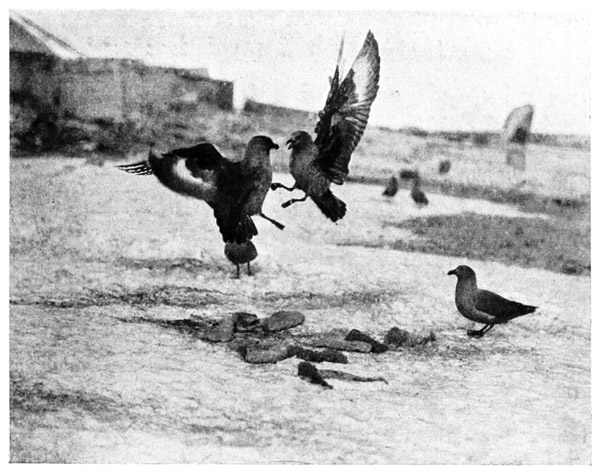
Fig. 71. “Leapt at one another into the Air”
(Page 129)

Fig. 72. A Skua by its Chick
(Page 131)
When one of the parent Skuas is on the ground
near its nest, on the approach of anyone it throws
its head back, opens its wings, and loudly proclaims
its whereabouts with its raucous cawing notes.
When hovering over food, and at other times when
not alarmed or angry, the sounds made by a Skua
are very like those of the common Herring Gull,
and not altogether unmusical at times, especially
when making the little shrill piping note, by which
I have often thought that gulls so nearly imitate
the squeaking of a block in its sheaf.
When the penguin chicks are hatched, the Skuas
prey upon these in a most cruel manner, and should
a chick wander away from the protecting old birds,
a Skua is almost certain to pounce upon and kill
it. This it does by pecking its eyes out, after
which, with powerful strokes of its beak, it gets
to work on its back and quickly devours the
kidneys.
The dead bodies of hundreds of chicks are seen
strewn about the rookery, and especially in the
neighbourhood of the Skuas' nests, as very often
they carry them there. All these dead chicks are
seen to have two holes picked through their backs,
one on each side, corresponding to the position
of each kidney.
Besides the penguins' eggs and young, there is
another fruitful source of food for the Skuas to be
found along the Antarctic coasts at the early part
of the year, and that is during the time when the
seals are bringing forth their young upon the sea-ice.
The Skuas attend upon them then, and devour
the after-births. In the second volume of the
Discovery reports Dr. Wilson mentions that
large numbers of Skuas were noticed at Granite
Harbour, and I have no doubt that they had
congregated there for this purpose, as when passing
the spot on a spring journey along the sea-ice in
1912, we saw many hundreds of Weddell seals with
their young. So many were there, that as we lay
in our sleeping-bags during the night, the bleating
of the little calves near our tents conveyed to our
half-awakened senses the impression that we were
in the midst of lambing fields at home!
The soft parts are coloured as follows:
Bill, black.
Iris, dark brown.
Legs, toes, and webbs, black, excepting a patch of
bright blue just above the tibio-metatarsal joint, in
young fledglings. Wholly black afterwards. (They
have a very fine spread of webb.)
Claws, black.
The feathers of the head, neck, and breast vary
from very light buff, or almost white, to rich dark
brown.
| McMurdo Sound | Cape Adare | ||
|---|---|---|---|
| 1902 | 1903 | 1911 | |
| 1st bird arrived | Nov. 3 | Oct. 25 | Oct. 26 |
| 1st egg seen | Dec. 9 | Dec. 2 | Nov. 29 |
| 1st chick hatched | Jan. 1 | ||
| Last bird left | Mar. 30 | Apr. 7 | |
A SHORT NOTE ON EMPEROR PENGUINS(9)
The Emperor is by far the largest of all penguins,
weighing between 80 and 90 lbs. It is also a
particularly handsome and graceful bird. By
nature it seems much like the Adélie, except that
its general demeanour is extremely dignified, and
its gait, as it approaches you over the snow, slow
and deliberate.
The most marked difference in the habits of the
Adélie and the Emperor lies in the respective
seasons at which each lays and incubates its eggs.
Unlike the Adélie, which, as we have seen, chooses
the warmest and lightest months of the year for the
rearing of its young, the Emperor performs this duty
in the darkest, coldest, and most tempestuous time.
The only reason that has been suggested for this custom
is that many months must pass before the chicks
are fully fledged. Were they hatched in December
(midsummer) as are Adélies, autumn would find
them still unfledged, and probably they would
perish in consequence, whereas, being hatched in the
early spring, they are fostered by their parents until
the warmer weather begins, and then have the
entire summer in which to accomplish their change
of plumage.
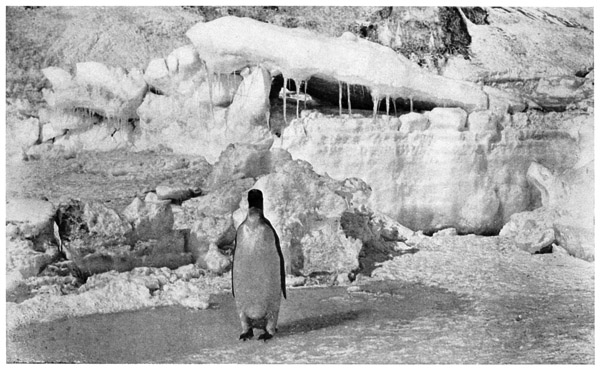
Fig. 73. AN EMPEROR PENGUIN
(Page 134)
The only Emperor rookery known to man at the
present day was discovered by Lieuts. Royds and
Skelton, of Captain Scott's first Antarctic expedition,
on the sea-ice beneath Cape Crozier. Here in the
dark days of July this extraordinary bird lays its
one egg upon the ice.
In the winter of 1911 a very brave journey was
made to this spot by a party of Captain Scott's
officers, consisting of Dr. Wilson, Lieut. Bowers
and Mr. Cherry-Garrard. The experiences of this
little band were so terrible that it is remarkable
they ever returned to tell of them. Temperatures
of −78° F. were encountered, and the most severe
blizzards at lower temperatures than any sledging-party
had yet endured. Under these truly terrible
conditions the Emperors lay their eggs and hatch
their young.
The mortality under such circumstances is very
high, as one would expect. Avalanches of ice fall
from the cliffs above, crushing many of the parent
birds, and causing hundreds of eggs to be deserted.
As Dr. Wilson stated, the ice cliffs beneath which
these remarkable animals sat were so unstable that
no man in his senses would camp for a single night
beneath them. In spite of this, evidence showed
that after an avalanche of ice blocks from above,
which had caused some of the Emperors to leave
their eggs on the ice and bolt in terror, many of
them had returned and continued to sit on the eggs
which had been frozen and killed by the frost in
their absence, continuing to do so long after they
were completely rotten. Indeed, in their desire
for something to hatch, some who had been deprived
of their eggs, were seen to be attempting to incubate
pieces of ice in their place, and, unlike Adélies,
they seem ever ready to snatch and foster the young
of their neighbours.
The first time the rookery at Cape Crozier was
visited, not above one thousand birds occupied
it. On the second occasion their numbers were
far short of this. By the springtime only one
out of ten or twelve birds are seen to be rearing
young, so it is obvious other rookeries await discovery
in other parts, as there are a large number
of Emperors to be seen along the Antarctic coasts.
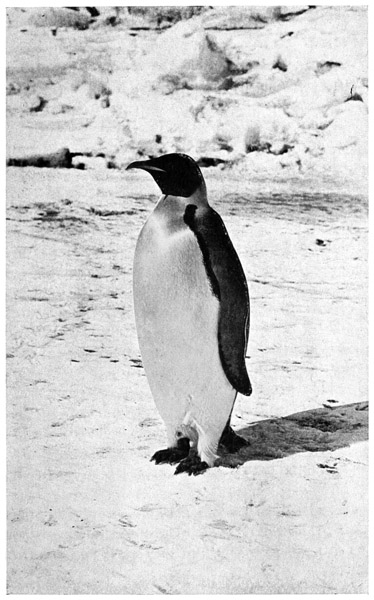
Fig. 74. PROFILE OF AN EMPEROR
(Page 134)
When in the Terra Nova we made our way
along the face of the great Barrier to the eastward,
we saw large numbers of Emperors, especially to
the extreme eastward where a heavy hang of pack-ice
blocked our further passage, and I have little doubt
that future exploration will disclose a rookery or
rookeries in this direction.
Again, in the spring of 1912, when nearing the
end of a sledge journey from the northward to Cape
Evans we passed large gatherings of Emperor
penguins on some very old sea-ice under the Barrier's
edge, along the southern end of McMurdo Sound,
and it seems not at all unlikely that they may
breed here too. Unfortunately we were unable at
that time to make detours, so had to leave the
question unsettled, but if they do breed here, they
must have far to go to get food during those
winters when the sea-ice does not break out of the
Sound.
The growth of the Emperor chick is slow, when
compared with the mushroom-like rate at which
the Adélie youngster increases its substance.
Approximately the egg is laid at the beginning
of July and hatched out some seven or eight weeks
later. During the period of incubation, which duty
is shared by all, male and female alike, the egg is
held in a loose fold of skin at the lower part of the
abdomen, the skin of the adults being worn bare of
feathers in this region.
When hatched out, the chick is coveted by every
unoccupied adult, and so desperate at times are the
struggles for its possession that very frequently it
gets injured or killed by its would-be foster parents.
Dr. Wilson has estimated the mortality among the
chicks before they shed their down at 77 per cent.
and thinks that half this number are killed by
kindness. Very often, in fact, they will crawl under
projecting ledges of ice, or anywhere to escape the
attentions of half a dozen or so of adults, all bearing
down upon them together, only to meet and
struggle for their possession, during which process
the innocent cause may get trampled and clawed to
death. So strong is the maternal instinct of the
Emperor, that frozen and lifeless chicks are carried
about and nursed until their down is worn away.
In fact, the scientists who visited the rookery were
unable to get good specimens of dead chicks, as all
of these had been treated in this way.
Fortunately the Emperor chick escapes the
depredation of the Skua gull, which plays such
havoc in the Adélie rookeries, because the Skua does
not come south until the summer, by which time the
Emperor chicks are well grown. As in the case of
the Adélies, the black throat is not acquired until
the second moult. When this has taken place, the
bird looks remarkably handsome. The bill, which
is curved and tapering, is bluish black, but the
posterior half of the mandible is coloured a beautiful
lilac. The head and throat are black, whilst on each
side of the neck is a patch of vivid orange feathers.
The rest of the body is marked in the same way as
the Adélie.
The mortality among the chicks being so very
high, the probability is that the life of the adult is
long, as otherwise the species could hardly survive.
Dr. Herbert Klugh has calculated that the Emperor
penguin lives for thirty-five years.
Evidence goes to show that the young birds
spend their immaturity on the pack-ice, as all those
sighted and collected on the pack at any distance
to the northward have been immature, and
no immature birds have been seen along the coasts
at any time during the summer.
The food of the Emperor mainly consists of fish
and crustaceans. There are invariably many small
pebbles in the stomach. Like Adélies they must of
course have open water within reach in order to
get food, and in the neighbourhood of Cape Crozier
this is always to be found, as the rapid tide there
keeps the sea from freezing in over a considerable
area, so that probably they never have to walk
more than a mile or two to get food.
The cry of the Emperor is very loud and travels
far across the ice. When sledging over the sea-ice
in the spring, in the neighbourhood of Cape Adare,
a curious sound was heard at times, reminding one
strongly of the “overtone” notes of a ship's steam
horn. The sounds puzzled us at the time, but I
think now that most probably they were made by
Emperor penguins.
The egg of the Emperor is white, pyriform in
shape, and weighs just under 1 lb.
My own experience of these birds being limited
I do not intend to enter deeply into the subject.
The only surviving member of the band who visited
Cape Crozier during the winter is Mr. Cherry-Garrard,
and it is much to be hoped that some day
he will write us an account of what he saw there.
In the meantime for further details of the habits
and morphology of the species, the reader is referred
to Dr. Wilson's work, published in the second
volume of the British Museum Reports, on the
National Antarctic Expedition 1901–1904.
PRINTED AT
THE BALLANTYNE PRESS
LONDON
(1)
Pygoscelis adeliæ.
(2)
Sea-Leopard = Stenorhinchus leptonyx.
(3)
Fig. 12.
(4)
Fig. 37.
(5)
This “watch-bill” was kindly kept for me by Mr. Priestly on
his meteorological rounds, the nests being near the thermometer
screen.
(6)
Fig. 62.
(7)
Fig. 70.
(8)
This was invariable at Cape Adare.
(9)
Aptenodytes forsteri.
Transcriber's Note:
The following is a list of corrections made to the original. The
first passage is the original passage, the second the corrected one.
- Figure 15:
SOME ARE WALKING AND SOME “TOBOGANNING”
SOME ARE WALKING AND SOME “TOBOGGANING” - Figure 51:
Fig. 51. SEA LEOPARDS “LURK BENEATH THE OVERHANGING LEDGES
Fig. 51. SEA-LEOPARDS “LURK BENEATH THE OVERHANGING LEDGES - Page 88:
‘porpoise” madly away for a few hundred yards,
“porpoise” madly away for a few hundred yards, - Page 123:
brown; mandible, blackish on dorsum; maxilla
brown; mandible, blackish on dorsum; maxilla, - Page 134:
Unlike the Adélie, which, as we have seen, choses
Unlike the Adélie, which, as we have seen, chooses
Featured Books

The World of Romance
William Morris
. In this magazine Morris first found his strength as a writer, and thoughhis subsequent literary a...

Selections from the Writings of Lord Dunsany
Lord Dunsany
lid black; /* a thin black line border.. */ padding: 6px; /* ..spaced a bit out from the gr...

A New Pocket Gopher (Genus Thomomys) From Wyoming and Colorado
E. Raymond Hall
pe.—Male, adult, skull and skin, no. 25628 Mus. Nat. Hist. Univ. Kansas;from 8 mi. N and 19-½ mi....

The People of the Mist
H. Rider Haggard
T ARGUMENT XXXV. BE NOBLE OR BE BASE XXXVI. HOW OTTER CAME BACK XXXVII. “I AM REPAID, QUEEN” XXX...

Wild Kitty
L. T. Meade
lid black; /* a thin black line border.. */ padding: 6px; /* ..spaced a bit out from the gr...

The Battery and the Boiler: Adventures in Laying of Submarine Electric Cables
R. M. Ballantyne
think so, Johnson?” asked the steward.“What makes me think so, stooard?” replied the cook, who...

Mr. Punch on the Warpath: Humours of the Army, the Navy and the Reserve Forces
CHARLES PEARS, E. T. REED, J. BERNARD PARTRIDGE, G. D. ARMOUR, FRED. PEGRAM,GEORGE DU MAURIER, PHIL...

A House-Boat on the Styx
John Kendrick Bangs
the Nineteenth Century? Had not he dealt satisfactorily with all, whether it was in the lineof fer...
Browse by Category
Join Our Literary Community
Subscribe to our newsletter for exclusive book recommendations, author interviews, and upcoming releases.
Comments on "Antarctic Penguins: A Study of Their Social Habits" :